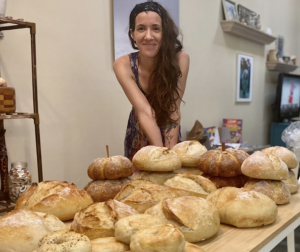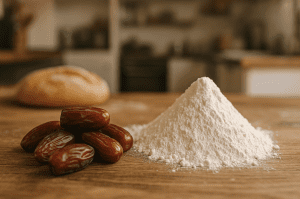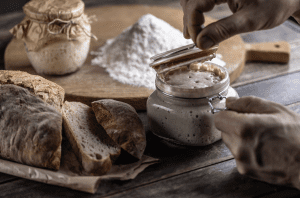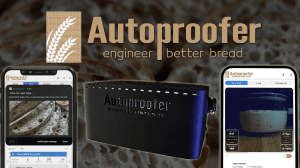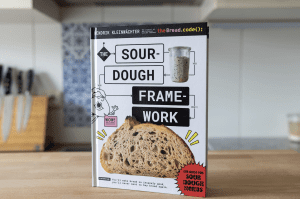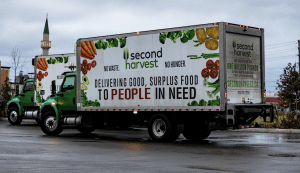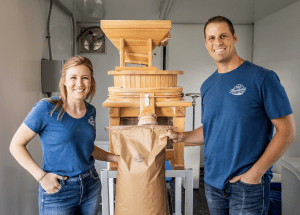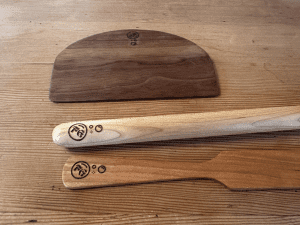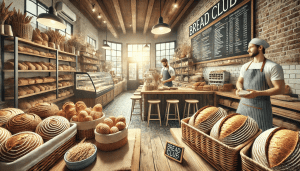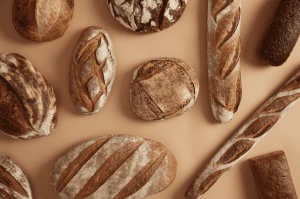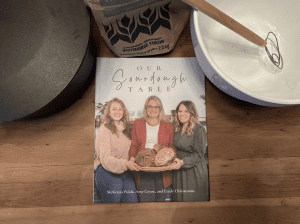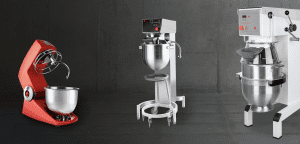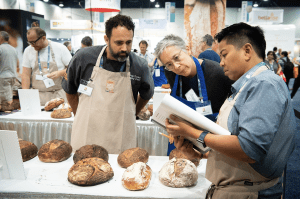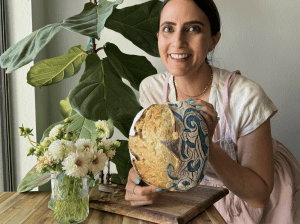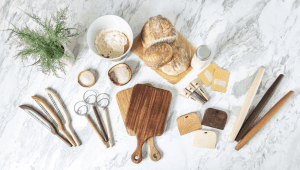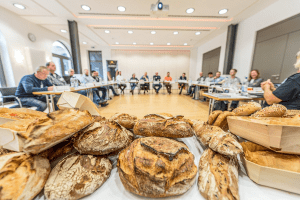LEARN ABOUT US
Welcome to The Sourdough People sourdough bread website – the global hub for all things sourdough! 🍞✨ Founded in Canada and expanding to the United States with more countries on the way, we unite sourdough enthusiasts worldwide in a multi-language, multi-cultural, inclusive, and friendly community where beginners, intermediates, and advanced bakers can learn, share, and grow together. Our TSP Shop marketplace offers everything you need for your personalized sourdough baking goals, including industry-leading products and brands, premium handmade tools, kitchen equipment, baking supplies, organic sourdough starters, sourdough-themed clothing and accessories, digital downloads, eBook PDFs, how-to guides, recipes, and more. Dive into our TSP Blog for technically written expert product reviews, exclusive interviews with social media influencers, trendsetters, and top bakers, as well as breaking news, current events, and industry updates that keep you informed and inspired. Have a question? Our sourdough concierge provides personalized custom support and expert guidance to help you troubleshoot and succeed in your sourdough adventure. Ready to grow your brand? Use our D2C page to sell your products and reach a global audience. For business inquiries, collaborations, or partnerships, reach out through our contact form. Join us to celebrate the art and science of sourdough bread baking in a community built on kindness, knowledge, and creativity. 🌎🥖
*Shipping available in Canada 🇨🇦 + USA 🇺🇸 and more regions coming soon!

RECENT FEATURES
Interview With Sourdough Bread Microbakery Owner & Educator Mandy Clark of Palm Beach Gardens, Florida
At The Sourdough People, we believe that every loaf has a story—and behind every great loaf is a baker whose hands, heart, and history shape every crumb. Today, we are honored to introduce you to Mandy Clark, a Florida-based microbaker, sourdough educator, and the creator of Living Well with Mandy. Mandy’s journey into sourdough began…
Date Seed Kernel Powder Flour and Moroccan Sourdough Bread: A Delicious Way to Reduce Food Waste
Moroccan sourdough bread is more than nourishment. It is an heirloom of memory, sustenance, and social meaning—a golden loaf passed from generation to generation, shaped by hands that measure without measuring and bake without clocks. For centuries, baking in Morocco has reflected a deep, intuitive relationship with the land and its grains. But today, that…
Wood Pulp Banneton Bread Proofing Basket Production, Manufacturing, and Suppliers in Canada – A Call to Action for the Canadian Wood Pulp Industry
Canada has everything it needs to lead in sustainable bread-making tools: vast forests, world-class pulp producers, and a thriving artisan baking community. Yet one of the most essential tools of sourdough baking—the wood pulp banneton—is almost entirely imported. These baskets, crucial for shaping and fermenting dough, are manufactured overseas and shipped across oceans to Canadian…
What To Do With Sourdough Bread Ends, Bits, and Pieces Instead of Throwing Them Out: 40+ Creative Ways to Use Leftover Sourdough Scraps
If you love sourdough bread, you know the scenario: a few uneaten slices, crusty ends, torn bits, hardened heels, dried pieces, or a half-loaf slowly going stale. Maybe you’ve even got a freezer bag full of saved odds and ends you promised to “use eventually.” These sourdough remnants—leftover slices, broken chunks, forgotten pieces, or crumb-laden…
Why Sourdough Bread Is the Perfect Carb for Spring and Summer: Gut Health, Freezer-Friendly, and Endless Pairings
When most people think of sourdough bread, they picture a thick, hearty loaf accompanying rich autumn stews or cozy winter meals. But sourdough is far more versatile — and it’s time to reimagine it for what it truly is: the ultimate spring and summer companion. If you’ve believed sourdough is too “heavy” for warm weather,…
How to Make Reusable Bread Bags with Reclaimed, Repurposed Fabrics Available Locally Across Canada, the United States, and Beyond—Reducing Greenhouse Gas Emissions
How to make a reusable bread bag that’s beautiful, functional, sustainable, and meaningful starts with choosing the right materials, understanding your bread, and selecting a design that preserves freshness while supporting the environment. In today’s world of sustainability and conscious living, finding simple ways to lower our environmental footprint has never mattered more. For sourdough…
Wood Projects Await Handcrafted Hardwood Sourdough Bread Tools Locally Made in Canada
Are you looking to stretch your dollars, support Canadian artisans, and bring authentic quality into your sourdough baking journey? You’ve found the right place. In a world full of mass production and disposable tools, there’s something deeply meaningful about choosing pieces that are handmade, sourced locally, and built to last for generations. Today’s consumers are…
Sourdough Bread in Space: How to Bake the First Loaf Beyond Earth’s Atmosphere Using Intergalactic Ingredients in Zero Gravity
This is an exclusive feature article on The Sourdough People, written and published with one goal in mind: to shake up creativity and thinking in the global sourdough industry by taking our thoughts beyond Earth itself. Sourdough has always been a rebellious, untamed tradition—a wild dance between flour, water, microbes, and time. But what happens…
Sourdough Bread Product Reviews
At The Sourdough People, we are passionate about celebrating the best tools, supplies, and innovations in sourdough baking. From handcrafted scoring lames to temperature-controlled proofing systems, the products a baker chooses can dramatically impact their success. The right Dutch oven creates a crackling crust, the right flour encourages fermentation, and the right proofing basket shapes…
Sourdough Bread in Thailand: Micro Bakeries, Cafes and Restaurants
Trump’s Canadian Connection: How a Gold Rush Business in Bennett, British Columbia, Started His Family’s Fortune With Gold Miners, Sourdough Bread, and a Boomtown Economy
Donald Trump’s name is synonymous with many things, but few know that the foundation of his family’s fortune was not built in New York but in Northern British Columbia, Canada, during the Klondike Gold Rush. Long before Trump Tower and luxury hotels, the Trump dynasty began with Friedrich Trump, Donald Trump’s grandfather, who ran a…
Interview With Jessie Youngblood of Doughbauchery™ Microbakery in Los Gatos, California
At The Sourdough People, we are passionate about highlighting the dedicated artisans behind the loaves that nourish both body and soul. Today, we are honored to feature Jessica Youngblood, a talented microbaker and the founder of Doughbauchery™, an organic sourdough microbakery based in Los Gatos, California. Jessica’s journey into sourdough began as a personal exploration—one…
Bernd das Brot and Germany’s Regional Sourdough Bread Varieties
Germany is a nation where bread (Brot) is not merely a staple, but a deeply ingrained part of its cultural fabric. Across centuries, the country has developed an unparalleled Brotkultur (bread culture), with over 3,000 officially recognized varieties, many of which rely on the meticulous art of Sauerteig (sourdough fermentation). The slow, natural rise of…
The Perfect Loaf of Sourdough Bread Does Not Exist: Perfectionism is a Subjective Personal Opinion Based on Your Nuanced Life Experiences
In the world of sourdough baking, the pursuit of the perfect loaf can become an endless quest. Many bakers chase an ideal—an open, airy crumb, a golden blistered crust, the right balance of chew and crispness. But no matter how much experience or skill one gains, the perfect loaf remains elusive. That’s because perfection is…
Top 10 Best Sourdough Bread Facebook Groups for Beginners, Intermediate, and Advanced Bakers to Learn, Share, and Grow
At The Sourdough People, we believe in the power of community, connection, and collaboration. Sourdough baking is a journey—one that is more enjoyable and successful when shared with others. Whether you’re troubleshooting a struggling starter, perfecting fermentation timing, or searching for inspiration in new recipes, the right Facebook group can provide the help, support, and…
What is HealthFerm and How Their Research Study Advances Sourdough Bread Education and Fermented Food Culture
Sourdough bread is more than just a food staple in Europe; it’s a cultural phenomenon deeply rooted in countries like Germany, France, and Italy, where it is celebrated not only for its rich flavor and natural leavening but also for its perceived health benefits. From the rustic loaves of rural small towns to the artisan…
Sourdough Starter vs. Sourdough Culture: What’s The Difference, Why Does It Matter, and How Are They Interconnected?
This is a special edition article from The Sourdough People for those who seek maximum context while learning, as we strive to cater to diverse interest groups and readership styles. By offering in-depth explorations alongside more accessible content, we aim to provide a balanced approach across our published content. In the realm of artisanal baking…
How the Melis Family Became the World’s Oldest by Eating Sourdough Bread Daily in Sardinia’s Blue Zone: Secrets of Longevity, Local Culture, and the Ultimate Travel Guide to Perdasdefogu, Italy
In the rugged hills of Sardinia, Italy, where ancient stone villages overlook the sparkling Mediterranean Sea, lives the Melis family—an extraordinary clan known for holding the Guinness World Record as the world’s longest-living siblings. With a collective age of 861 years and the eldest reaching 109, the Melis siblings have fascinated scientists and longevity experts…
How to Say ‘Sourdough Bread’ and ‘Sourdough Starter’ in the World’s Top 20 Most Spoken Languages
At The Sourdough People, we love sourdough, we love people, we love community, and above all, we cherish kindness. Today, we embark on a journey across the world, exploring how different cultures refer to sourdough bread. But this is more than just words—this is about history, tradition, and the deep connection between people and their…
How To Do SEO for Sourdough Bread Micro Bakeries, Flour and Wheat Berry Brands, and Local and Regional Milling Companies
SEO (Search Engine Optimization) is not just about ranking high on search engines—it’s about creating a seamless digital ecosystem that attracts customers, earns their trust, and guides them toward making a purchase or engaging with your brand. Whether you operate a sourdough micro bakery, a flour or wheat berry brand, or a local/regional milling company,…
Original XBox Video Game Console Creator Jonathan “Seamus” Blackley Bakes Sourdough Bread With Ancient Egyptian Culture
Main photo from XBox Subreddit. Here at The Sourdough People, we pride ourselves on diving into the most unique, rare, and abstract stories related to the world of sourdough, fermentation, and ancient culinary traditions. But today, we’re taking a detour into the world of technology and video games—only to find that the most unexpected of…
How to Make a Sourdough Starter in Canada While Considering Local Climate, Weather, Temperature, Humidity, Altitude, Water Quality, and Beyond
Learn how to make and maintain a sourdough starter culture in Canada using a precise, science-backed process with clear, methodical steps. This comprehensive guide accounts for the diverse environmental variables across all provinces and territories, ensuring your fermentation process thrives regardless of regional climate conditions, temperature fluctuations, humidity levels, altitude variations, or water composition. While…
Complete Guide to Astra Razor Blades for Sourdough Bread Scoring
Scoring sourdough bread is one of the most essential steps in the baking process, determining the final shape, crust texture, and controlled expansion of a loaf. Proper scoring ensures that steam releases in a predictable manner, preventing random ruptures while enhancing the aesthetic appeal of the bread. Achieving clean, precise cuts requires a sharp, smooth-gliding,…
Sourdough Concierge: Get Your Sourdough Questions Answered and Troubleshooting Help from Sourdough Bakers with First-Hand Experience in Any Language
Sourdough baking is both an art and a science, demanding patience, intuition, and knowledge of fermentation, hydration, and baking techniques. It’s an incredibly rewarding process, but it can also be frustrating, confusing, and unpredictable. Maybe you’re trying to figure out why your sourdough starter isn’t bubbling, why your dough feels too wet and unmanageable, or…
Visit Rossland, British Columbia, for Local Tourism Experiences and Learn About the History of Sourdough Alley During the Gold Prospecting Settler Days
Rossland, British Columbia, is a hidden gem in the Kootenay region, offering rich history, thrilling outdoor activities, and a deep connection to Canada’s gold rush era. Known for its stunning mountain scenery, world-class skiing, and vibrant arts community, Rossland is a must-visit destination for those seeking adventure and historical exploration. But beyond the hiking trails…
Autoproofer: Brendan’s Loaf Hacker Results Spark a Revolutionary Sourdough AI Tool Fundraising Campaign on Kickstarter
At The Sourdough People, we cherish the heritage and craftsmanship of sourdough breadmaking. Today, we’re delighted to introduce an innovation that combines the artistry of traditional baking with the precision of cutting-edge technology: Autoproofer App and Autoproofer AI. These revolutionary tools are changing the game for bakers, delivering unmatched consistency, control, and confidence in every…
The Sourdough Framework Book Written by Hendrik Kleinwächter
For anyone passionate about sourdough breadmaking, The Sourdough Framework by Hendrik Kleinwächter is an unparalleled resource that combines science, history, technical know-how, and the artistry of baking. This groundbreaking book isn’t just a collection of recipes; it’s an educational journey that teaches the science and craft of sourdough from the ground up. Every chapter, glossary…
Second Harvest Food Charity in Canada Donates 1,600 Pounds of Sourdough Bread to Families in Terrace, British Columbia
In a world where the simple acts of sharing and community care often get overshadowed by busy schedules and global challenges, a story from the small town of Terrace, British Columbia, shines brightly. On December 6, 2024, over 1,600 pounds of frozen bread, including sourdough and other varieties, made its way to Terrace, destined to…
Thought Leadership in the Sourdough Industry: Why Disconnecting From Social Media and Trends Is Essential to Pursuing Your Unique Niche Passions
The sourdough industry thrives on creativity, craftsmanship, and passion, yet in recent years, the rise of social media and industry-wide trends has diluted its essence. While platforms like Instagram and TikTok have democratized the sharing of ideas, they have also fostered a culture of replication. Recipes are borrowed, slightly altered, and rebranded; product ideas are…
Influencer Interview With Emily of Country Roads Sourdough
Meet Emily, the heart and soul behind Country Roads Sourdough, whose journey through motherhood, sourdough baking, and entrepreneurship has captivated a vibrant community of bread enthusiasts. Raised on a small farm in Vermilion Ohio, Emily’s roots are firmly planted in the simplicity and joy of country life. From riding horses as a child to moving…
Heartland Craft Grains: Reviving Heirloom and Ancient Grains in Lodi Valley, Wisconsin
At The Sourdough People, we believe that exceptional baking begins with extraordinary ingredients. That’s why we’re thrilled to highlight the inspiring story of Heartland Craft Grains, a family-operated farm and mill located in the verdant Lodi Valley of Wisconsin. This remarkable endeavor is bringing the art of grain farming back to its flavorful, nutrient-rich roots…
3 Wild Grasses Evolved to Make Bread Wheat Possible 8,000–11,000 Years Ago in the Middle East: Triticum dicoccoides, Aegilops tauschii, and Aegilops sharonensis
Bread, in its many forms, has been a foundational part of human history. It is more than sustenance; it is a cultural icon, a symbol of community, and an enduring testament to human ingenuity. At the heart of bread’s story is wheat, the crop that makes breadmaking possible. But wheat did not simply appear as…
Reviewed: Floaty Goat Sourdough Tools
Welcome back to The Sourdough People blog, where we delve into quality products for the dedicated sourdough community. Today, we’re excited to review Floaty Goat Sourdough Tools—a set of handcrafted baking essentials from Leeds, England in the United Kingdom. This thoughtful collection includes a handmade bench scraper, Danish dough whisk, and spurtle—all carefully designed for…
How to Start a Sourdough Bread Club Subscription Service: Guide
Starting a sourdough bread club subscription service (weekly/monthly) can be an exciting way to share your passion for sourdough while building a consistent revenue stream. Whether you’re a home baker looking to grow your business or already have a customer base and want to add a new layer to your offerings, a bread club could…
Sourdough Bread Workshops in Canada
In today’s world, where convenience often takes precedence over quality and community connections, sourdough bread workshops offer a refreshing alternative. Across Canada, these workshops are emerging as a vehicle for social change, fostering healthier eating habits, saving families money, and bringing people together in ways that celebrate diversity and build community resilience. By focusing on…
Book Review: Our Sourdough Table, Written by Emily Christensen, Amy Coyne, and McKenna Pulda
Purchase ebook, soft cover, coil bound, and hard cover versions. For every sourdough lover, there’s something magical about the process of transforming a humble starter culture into a loaf bursting with flavor, texture, and history. If you’ve ever felt the joy of sourdough or are curious about embarking on this fulfilling journey, Our Sourdough Table…
Wine Pairings and Sourdough Bread in the BC Wine Industry
British Columbia (BC) is home to a rapidly growing and exciting wine industry that is earning recognition for its unique terroirs, diverse wine styles, and commitment to quality. Just as the world of wine celebrates depth and complexity, so too does the art of sourdough bread baking—a tradition rooted in time-honored techniques, fermented with care,…
Palouse Heritage: Heirloom, Landrace, and Ancient Grains
At The Sourdough People, we are always searching for the finest quality grains to inspire our community of bakers and elevate the flavors, textures, and nutritional benefits of sourdough. Today, we are excited to share the story of Palouse Heritage, a family-run farm from Washington State’s Palouse Country that is reviving heirloom, landrace, and ancient…
Varimixer Brand Mixers: History, Products, Company, and Insights
Varimixer, a leading name in professional-grade kitchen equipment, has revolutionized the foodservice industry with its high-performance, reliable, and durable mixers. For over 100 years, this Danish brand has provided chefs, bakers, and foodservice professionals with powerful and versatile machines designed to tackle a wide range of culinary tasks. Varimixer mixers are used worldwide in bakeries,…
What is the International Baking Industry Expo (IBIE)?
The International Baking Industry Expo (IBIE), also known as “The Baking Expo,” is the largest and most comprehensive event dedicated to the grain-based food industry in the Western Hemisphere. Held every three years in Las Vegas, Nevada, IBIE gathers professionals from every segment of the baking community—from artisan bakers and pastry chefs to large-scale manufacturers…
Guide: Ethiopian Sourdough Injera Flatbread
የኢትዮጵያ እንጀራ ያለውን ታሪክና በተለየ ባህላዊ ጣዕም የሚሰጥ እንጀራን በዚህ ዝርዝር መመሪያ ያግኙ። ከሐረቀኛ የእስር እህል የተሰራ ይህ ሳር ጣፋጭ ቂጣ እንዴት በኢትዮጵያ ምግብ እንደሆነ እና እንዴት እንደሆነ ታሪካዊ ባህላዊ ምስክር ያግኛል ተማሩ። ቡክላውን የምቀኛ ሂደት፣ ባህላዊ የቅምሻ ዘዴዎች እና የእንጀራ እሴት በኢትዮጵያ ምግብ እንደሆነ ያብራርታል። ከዚህ በላይ እንጀራ በቤት ለመስራት ዝርዝር የተሰራ መጠቃቀም አገልጋይ…
Interview With Katrina From ‘The Sourdough Mama’ on Instagram and TikTok
As summer days grow shorter and we gradually transition into the fall and winter shopping season, it’s the perfect time to start planning ahead. To help with your sales and campaign planning year over year, take advantage of the sourdough calendar we’ve created. And speaking of planning, what better way to prepare for the cozy…
Sourdough Raft Race in Edmonton Alberta on the North Saskatchewan River
The Sourdough Raft Race is one of Edmonton’s most anticipated annual events, blending creativity, camaraderie, and competition in a delightful day on the North Saskatchewan River. Held every summer, this event attracts both participants and spectators from all over, eager to partake in the thrilling river adventure. If you’re new to the Sourdough Raft Race…
Kitesurfing With Sourdough Bread Across the English Channel
Welcome to The Sourdough People, your go-to source for everything sourdough. Today, we delve into a fascinating story of innovation and tradition intertwined in the most unexpected way. On July 4th, 2024, two French kitesurfers embarked on an extraordinary journey across the English Channel, carrying barrels of sourdough bread to be used in brewing. This…
Interview With Hercules From ‘Will It Sourdough’ on Instagram and TikTok
Thank you for visiting The Sourdough People website and marketplace! We are thrilled to have you here and excited to share this detailed interview feature with you. In this interview, you’ll get to know Hercules Noble, a passionate sourdough baker who has journeyed from the United Kingdom to New Zealand, finding a unique blend of…
Community Coalescence in Sourdough with Professor Angela Oliverio from Syracuse University
The fascinating world of sourdough bread, with its distinctive tang and complex flavor, is a testament to the wonders of fermentation. Each loaf is the result of an intricate dance performed by a unique microbiome—a community of yeasts and bacteria that work together to transform simple ingredients into something extraordinary. The study of these microbial…
Barlow & Co. Handmade Wood Sourdough Products
Sourdough enthusiasts and professional bakers, we have some wonderful news to share with you. The Sourdough People are excited to welcome Barlow & Co wood sourdough tools, products, equipment, and supplies to our TSP Shop sourdough bread marketplace. Handcrafted with care and dedication in Utah USA, Barlow & Co is known for their exceptional quality…
Certified Bread Sommelier Training Course From The Akademie Deutsches Bäckerhandwerk Weinheim in Germany
The culinary world is witnessing a renaissance in artisan bread appreciation through the emergence of the Bread Sommelier, a term once reserved for experts in the wine industry but now extended to the domain of baking. This novel designation originates from the prestigious Akademie Deutsches Bäckerhandwerk Weinheim, which has pioneered the Brot-Sommelier-Zertifizierung. This program has…
click here to visit the main blog

FOLLOW ON INSTAGRAM
SOURDOUGH BREAD FAQS
What is Sourdough Bread
Sourdough bread is a traditional type of bread crafted through a natural fermentation process that utilizes a symbiotic culture of wild yeasts and lactic acid bacteria. This microbial community, known as a "sourdough starter" or "sourdough culture," serves as the natural leavening agent, eliminating the need for commercial yeast.
The process of making sourdough bread begins by mixing the sourdough starter with flour and water, forming a dough that is then left to ferment for an extended period, typically ranging from several hours to overnight. During this fermentation phase, the wild yeasts and bacteria present in the starter feed on the natural sugars found in the flour. As they metabolize these sugars, they produce carbon dioxide gas, which becomes trapped within the dough's gluten network, causing it to expand and rise.
One of the defining characteristics of sourdough bread is its distinctive tangy flavor, which results from the lactic and acetic acids produced by the bacteria during fermentation. The bread also boasts a chewy texture and a denser crumb compared to commercially leavened bread. Additionally, the acidity of the sourdough culture acts as a natural preservative, significantly extending the bread's shelf life by inhibiting the growth of mold and other spoilage organisms.
Sourdough bread has an ancient history, dating back thousands of years, and it continues to be cherished worldwide for its complex flavor profile and nutritional benefits. Many people find sourdough bread easier to digest than other types of bread, largely due to the natural fermentation process, which breaks down gluten and other potentially difficult-to-digest compounds present in the flour. This makes sourdough a popular choice for individuals with gluten sensitivities, although it may not be suitable for those with celiac disease.
The renewed interest in traditional baking methods and the growing appreciation for artisanal foods have contributed to sourdough bread's enduring popularity. Its unique taste, combined with its potential health advantages, makes it a beloved staple in modern kitchens around the world.
How To Make Sourdough Bread
Sourdough bread is made using a natural fermentation process that involves a sourdough starter.
Here's a general overview of how it's made:
Create the starter: To make a sourdough starter, you combine flour and water and leave it at room temperature for several days. During this period, wild yeasts and lactic acid bacteria from the surrounding environment naturally colonize the mixture, forming a living culture. This culture is what gives sourdough its distinctive flavor and leavening power. To maintain an active starter, you must "feed" it regularly by discarding a portion and adding fresh flour and water. This feeding process supplies the microorganisms with new nutrients, keeping them alive and thriving.
Mix the dough: When you're ready to bake, the sourdough starter is mixed with flour, water, and salt to form the dough. The specific ratios of these ingredients vary depending on the recipe and desired texture. Higher hydration levels produce a more open crumb, while lower hydration results in a denser loaf. The choice of flour also influences flavor and texture, with bread flour providing more gluten structure and whole grain flours contributing to a richer, more complex flavor.
Knead the dough: After the ingredients are combined, the dough is kneaded to develop the gluten network, which provides elasticity and structure. This step ensures the dough can trap the carbon dioxide gas produced during fermentation, allowing the bread to rise. Some bakers use the traditional kneading method, while others prefer the "stretch and fold" technique, particularly for high-hydration doughs. Both methods help align the gluten strands, creating a smooth, elastic texture.
Ferment the dough: Once kneaded, the dough undergoes a bulk fermentation, during which it rises at room temperature for several hours or even overnight. During this time, the wild yeasts and bacteria in the sourdough starter feed on the sugars in the flour, producing carbon dioxide gas, which causes the dough to rise. The bacteria also produce lactic and acetic acids, which contribute to the bread's tangy flavor and act as natural preservatives. Longer fermentation times result in more complex flavors and improved digestibility.
Shape the dough: After the dough has risen, it is gently turned out onto a floured surface and shaped into the desired form, such as a loaf, boule, or baguette. This step involves degassing the dough slightly to redistribute the gas bubbles, which helps achieve an even crumb structure. Proper shaping also creates surface tension, allowing the loaf to maintain its shape during the final rise and baking.
Proof the dough: Once shaped, the dough undergoes a second rise, known as proofing. This stage allows the dough to develop additional volume and flavor. Proofing can be done at room temperature for a few hours or in the refrigerator for an extended period, a method called "cold retardation." Cold proofing slows down fermentation, enhancing flavor complexity and making the dough easier to handle and score before baking.
Bake the bread: Finally, the dough is baked in a hot oven, typically at temperatures ranging from 450-500°F. High heat is crucial for achieving good oven spring and a crispy crust. Introducing steam during the initial baking phase keeps the crust soft, allowing the bread to expand fully before setting. This can be done by placing a pan of water in the oven or using a covered Dutch oven. The baking time depends on the size and shape of the loaf but generally ranges from 30-40 minutes. The bread is done when it reaches an internal temperature of about 200-210°F.
Sourdough Bread Versus Regular Bread
Sourdough bread is different from regular bread in several ways:
Fermentation process: Sourdough bread is made using a natural fermentation process that relies on wild yeasts and lactic acid bacteria, specifically lactobacilli. These microorganisms are naturally present in the environment and are captured and nurtured in a sourdough starter. During fermentation, the wild yeasts produce carbon dioxide gas, causing the dough to rise slowly, while the lactobacilli produce lactic and acetic acids, which give sourdough bread its distinctive tangy flavor, chewy texture, and slightly sour aroma. In contrast, regular bread is made using commercial baker's yeast (typically Saccharomyces cerevisiae), which ferments the dough much more quickly. This rapid fermentation process lacks the complexity of wild fermentation, resulting in a milder flavor and a softer, more uniform crumb structure.
Digestibility: Sourdough bread is generally easier to digest than regular bread because the natural fermentation process partially breaks down gluten and other complex carbohydrates in the flour. The lactic acid bacteria in the starter produce enzymes that pre-digest the gluten proteins and starches, making the nutrients more bioavailable and reducing the glycemic load of the bread. Additionally, the longer fermentation time helps neutralize phytic acid, an anti-nutrient that can inhibit the absorption of minerals like iron, zinc, and magnesium. This makes sourdough bread a more tolerable option for people with gluten sensitivities or digestive issues, although it is not suitable for those with celiac disease.
Shelf life: Sourdough bread has a longer shelf life than regular bread due to the natural acidity produced by lactic and acetic acids during fermentation. These organic acids lower the pH of the bread, creating an inhospitable environment for mold and spoilage bacteria. This preservative effect extends the bread's freshness without the need for artificial additives. As a result, sourdough bread stays fresh and flavorful for several days, making it a convenient option for people who consume bread less frequently.
Nutritional profile: Sourdough bread has a more favorable nutritional profile compared to regular bread due to the metabolic activity of the wild yeasts and bacteria. The fermentation process enhances the bioavailability of essential minerals, including iron, zinc, and magnesium, by breaking down phytic acid, which otherwise binds to these nutrients and prevents their absorption. Additionally, sourdough bread has a lower glycemic index than regular bread, meaning it causes a slower, more gradual rise in blood sugar levels. This is beneficial for maintaining stable energy levels and may be advantageous for people managing blood sugar-related conditions, such as diabetes.
Overall, sourdough bread is celebrated for its complex flavor profile, chewy texture, and potential health benefits compared to regular bread. Its traditional fermentation process not only enhances taste but also contributes to improved digestibility, extended shelf life, and a superior nutritional profile, making it a popular choice for health-conscious consumers and bread enthusiasts alike.
Health, Wellness, and Nutrition Benefits
Sourdough bread offers several potential health, wellness, and nutritional benefits:
Easier digestion: The natural fermentation process involved in making sourdough bread partially breaks down gluten and other complex carbohydrates present in the flour. During fermentation, the lactic acid bacteria produce enzymes that pre-digest proteins and starches, making the bread easier to digest for some people. This can be especially beneficial for individuals with mild gluten sensitivities, irritable bowel syndrome (IBS), or other digestive issues. However, it's important to note that sourdough bread is not gluten-free and may not be suitable for individuals with celiac disease.
Lower glycemic index: Sourdough bread has a lower glycemic index compared to regular bread, meaning it causes a slower and more gradual rise in blood sugar levels. This is due to the lactic acid bacteria in the sourdough starter, which modify the structure of the starches during fermentation, slowing down the digestion and absorption of carbohydrates. As a result, sourdough bread provides more sustained energy and may help regulate blood sugar levels, making it a beneficial choice for people with insulin resistance or type 2 diabetes.
Increased nutrient availability: The fermentation process in sourdough bread enhances the bioavailability of key nutrients, such as iron, zinc, magnesium, and B vitamins. This is because the natural acids produced during fermentation break down phytic acid, an anti-nutrient present in whole grains that binds to minerals and reduces their absorption. By reducing phytic acid levels, sourdough fermentation increases the availability of these essential nutrients, making the bread more nutrient-dense compared to regular bread.
Prebiotic properties: The lactic acid bacteria present in the sourdough starter exhibit prebiotic properties, which promote the growth of beneficial gut bacteria. These bacteria produce short-chain fatty acids during fermentation, which support gut health by nourishing the intestinal lining and maintaining a balanced microbiome. A healthy gut microbiome is linked to improved digestion, enhanced immune function, and even positive effects on mental health, as gut health is closely connected to brain function through the gut-brain axis.
Longer shelf life: Sourdough bread naturally has a longer shelf life than regular bread due to the acidity created by the lactic and acetic acids produced during fermentation. This acidity acts as a natural preservative by inhibiting the growth of mold and spoilage bacteria. As a result, sourdough bread stays fresh for a longer period without the need for artificial preservatives. This makes it a practical option for those who consume bread less frequently and want to minimize food waste.
It's important to note that the health benefits of sourdough bread can vary depending on the specific recipe, type of flour used, and the strains of wild yeasts and bacteria present in the sourdough starter. Additionally, individual digestive responses may differ. However, many people find that sourdough bread is a flavorful and satisfying alternative to regular bread, offering a range of potential health benefits along with its distinctive taste and texture.
What Are The Types of Sourdough Bread
There are many different types of sourdough bread, each with its own unique flavor, texture, and cultural background.
Here are some examples of popular types of sourdough bread:
Classic sourdough: This is the most traditional form of sourdough bread, made using a simple combination of flour, water, salt, and a sourdough starter. It has a distinctive tangy flavor, which comes from the natural fermentation process involving wild yeasts and lactic acid bacteria. The texture is typically chewy with a crisp, golden-brown crust and an open, airy crumb. Classic sourdough is versatile and pairs well with a variety of dishes, making it a staple in many households.
Whole wheat sourdough: This version is made with whole wheat flour, which gives the bread a rich, nutty flavor and a denser, more hearty texture. Whole wheat flour contains more bran and germ than white flour, providing additional fiber, vitamins, and minerals. The presence of bran can also interfere with gluten development, resulting in a tighter crumb structure. However, the natural fermentation process improves digestibility and nutrient availability, making whole wheat sourdough a nutritious and flavorful option.
Rye sourdough: Rye sourdough bread is crafted using a mixture of rye flour and wheat flour, resulting in a dense, moist texture and a complex, earthy flavor. Rye flour is lower in gluten than wheat flour, which makes the dough more challenging to work with and produces a tighter, less elastic crumb. The bread is also darker in color, ranging from light brown to deep, rich mahogany, depending on the proportion of rye flour used. Its bold flavor pairs well with savory toppings like smoked fish, cured meats, and cheeses.
French sourdough (Pain au Levain): Pain au Levain is a traditional French sourdough bread made with a mixture of white and whole wheat flours. It has a mild, slightly tangy flavor and a chewy crust with a soft, airy crumb. Pain au Levain typically undergoes a long fermentation period, allowing for complex flavor development and improved digestibility. It is known for its balanced acidity and subtle sweetness, making it an excellent choice for sandwiches, toast, or as an accompaniment to soups and stews.
Sourdough baguette: This type of sourdough bread is shaped into the iconic long, thin form of a baguette. It features a crisp, crackly crust and a soft, airy crumb with irregular holes. The sourdough version of the classic French baguette offers a slightly tangy flavor and improved shelf life compared to the traditional version made with commercial yeast. It is perfect for making bruschetta, crostini, or simply enjoying with butter and jam.
Sourdough ciabatta: Ciabatta is an Italian bread known for its light, open crumb structure with large, irregular air pockets and a chewy texture. Sourdough ciabatta is made using a sourdough starter and a high-hydration dough, typically with a blend of white and whole wheat flours. Its thin, crispy crust and airy interior make it ideal for sandwiches or as a dipping bread for olive oil and balsamic vinegar. The sourdough version adds a mild tanginess and enhances the bread's depth of flavor.
Sourdough focaccia: Focaccia is a flat, oven-baked Italian bread characterized by its soft, airy interior and golden, slightly crispy exterior. Sourdough focaccia is made using a sourdough starter and a blend of white and whole wheat flours, giving it a subtle tangy flavor and improved digestibility. It is typically topped with olive oil, sea salt, and herbs such as rosemary or thyme, but can also be customized with toppings like olives, cherry tomatoes, or caramelized onions.
These are just a few examples of the diverse world of sourdough bread. Each type can be customized by experimenting with different flours, hydration levels, fermentation times, and additional ingredients, allowing bakers to create a unique flavor and texture. Whether you prefer a dense, hearty loaf or a light, airy crumb, there's a sourdough variation to suit every taste.
How To Make Crust Crunchy and Tasty
To make a sourdough crust crunchy and flavorful, here are some effective tips to follow:
Use a high hydration dough: A high hydration dough (70-75% hydration) enhances crust crispiness and creates a more open, airy crumb structure. The increased water content allows for better steam generation during baking, which contributes to a thin, crackly crust. Additionally, the moisture in the dough encourages caramelization, giving the crust a rich golden-brown color and enhanced flavor.
Allow sufficient rise time: Sourdough bread requires a longer rise time compared to breads made with commercial yeast. Extended fermentation allows the natural yeasts and bacteria to fully develop the dough's flavor and structure. A longer bulk fermentation not only enhances the tangy flavor but also improves the crust's texture, resulting in a crispier, more flavorful exterior. Cold retardation (proofing the dough in the refrigerator overnight) can further enhance flavor complexity and crust formation.
Preheat your oven and use a baking stone or baking steel: Preheat your oven to its maximum temperature, typically between 475°F and 500°F (245°C to 260°C), and place a baking stone or baking steel on the middle rack. These tools retain and radiate intense heat, ensuring an even bake and promoting rapid oven spring. The high heat creates a crispy bottom crust while helping to achieve a beautiful, blistered outer layer.
Score the dough properly: Just before baking, use a sharp knife or a bread lame to score the top of the dough. This allows steam to escape in a controlled manner, preventing the crust from bursting irregularly. Proper scoring also contributes to a more defined and appealing crust texture. Make sure to make swift, confident cuts at a shallow angle to optimize expansion.
Create steam in the oven: Steam is crucial for achieving a crispy and glossy crust. When the dough first enters the hot oven, it rapidly expands, and the moisture on the surface keeps the crust flexible long enough for the loaf to fully rise. To generate steam, place a pan of hot water at the bottom of the oven or spray water into the oven right after placing the dough inside. Alternatively, baking the bread in a preheated Dutch oven traps steam naturally, promoting maximum oven spring and crust development.
Bake the bread until deeply golden brown: To achieve a crunchy and flavorful crust, bake the bread until it reaches a deep golden-brown color. This usually takes between 25 to 45 minutes, depending on the loaf's size, shape, and your oven's performance. A well-baked crust should be firm to the touch and produce a hollow sound when tapped on the bottom. Allowing the crust to develop fully ensures optimal caramelization and Maillard reaction, enhancing the flavor and crunch.
By following these techniques, you can achieve a sourdough loaf with a beautifully crisp and flavorful crust, complemented by a light, airy crumb. Experimenting with hydration levels, fermentation times, and baking temperatures can help you refine the perfect crust texture and flavor profile to suit your taste.
How To Store Sourdough Long Term
Sourdough bread can be stored at room temperature for several days in a bread box or a paper bag to maintain its crispy crust and chewy interior. However, if you need to store sourdough bread for a longer period, there are several effective methods:
Freeze the bread: Freezing is one of the best methods for preserving sourdough bread's flavor and texture over the long term. To freeze sourdough bread, first let it cool completely to prevent condensation, which can lead to freezer burn. Then, wrap the loaf tightly in plastic wrap or aluminum foil to protect it from air exposure. For added protection, place the wrapped loaf in a freezer bag, removing as much air as possible before sealing. Sourdough bread can be stored in the freezer for up to three months without significant loss of quality. When ready to eat, thaw the bread at room temperature for several hours or overnight in the refrigerator. To restore its crusty texture, reheat the bread in a preheated oven at 350°F (175°C) for about 10-15 minutes.
Refrigerate the bread (with caution): Refrigerating sourdough bread can extend its shelf life by a few extra days, but it may also dry out the crumb and make the bread stale more quickly. If refrigeration is necessary, wrap the bread tightly in plastic wrap or aluminum foil and place it in a resealable plastic bag or airtight container. This will help minimize moisture loss and prevent the bread from absorbing odors from other foods. Sourdough bread can be stored in the refrigerator for up to one week, but reheating it in the oven before serving is recommended to restore some of its original texture.
Store the bread in a cool, dark place: If freezer or refrigerator space is limited, sourdough bread can be stored in a cool, dark place, such as a pantry or cupboard. Wrap the bread in a breathable material, such as a paper bag or a clean kitchen towel, to allow air circulation and prevent mold growth. Avoid using plastic bags for room-temperature storage, as they trap moisture and make the crust soft. While this method preserves the bread's crustiness for a few days, it is best consumed within three to four days to ensure optimal flavor and texture.
Refresh the bread before serving: If sourdough bread becomes slightly stale, it can be revived by lightly misting the crust with water and reheating it in a preheated oven at 350°F (175°C) for about 10 minutes. This process rehydrates the crumb and restores the crust's crispness, making the bread taste almost as good as freshly baked.
It's important to note that sourdough bread is best enjoyed within a day or two of baking for optimal flavor and texture. While freezing preserves its quality better than refrigeration, all storage methods can affect the bread's chewiness and aroma over time. By following these storage techniques, you can maximize the shelf life of your sourdough bread while maintaining its delicious taste and satisfying texture.
What Are Sourdough Bread Starters
Sourdough bread starters are the essential ingredient used to make sourdough bread. They are a natural culture made from a simple mixture of flour and water that has been allowed to ferment over time. This fermentation process cultivates a symbiotic community of wild yeasts and lactic acid bacteria, which naturally leaven the bread and give it its distinctive tangy flavor.
How to make a sourdough starter:
To create a sourdough starter, combine equal parts of flour and water in a clean, non-reactive container (such as glass or food-grade plastic). Mix until smooth, cover loosely with a cloth or lid to allow airflow, and place the container in a warm, dark spot at room temperature. Over the next several days, wild yeasts and bacteria from the surrounding environment and the flour will colonize the mixture, initiating the fermentation process. As the starter ferments, it will develop bubbles and a slightly sour aroma, indicating that the microorganisms are actively producing carbon dioxide and organic acids.
Feeding the starter:
To keep the wild yeast and bacteria active, the starter must be "fed" regularly. Feeding involves discarding a portion of the starter and replenishing it with fresh flour and water, typically once every 24 hours at room temperature. This practice supplies fresh nutrients to the microorganisms, allowing the culture to thrive. The consistency of the starter should be like thick pancake batter. Over time, the starter will become stronger and more vigorous, usually within 5 to 7 days, at which point it is ready to be used for baking.
Using the starter in baking:
Once established, the sourdough starter can be used to make a variety of sourdough breads by mixing it with more flour, water, and salt to create the dough. The natural yeasts and bacteria in the starter ferment the dough, producing carbon dioxide gas, which causes the dough to rise. The organic acids produced during fermentation contribute to the bread's complex flavor and chewy texture. Each sourdough starter is unique, influenced by the local environment, the type of flour used, and the feeding schedule, giving each loaf its own characteristic taste.
Maintaining and storing the starter:
A sourdough starter can be maintained indefinitely as long as it is fed regularly and stored properly. If baking frequently, the starter can be kept at room temperature and fed daily. For less frequent use, the starter can be stored in the refrigerator and fed once a week to keep it active. If the starter goes dormant or becomes inactive, it can be revived by bringing it back to room temperature and feeding it several times until it becomes bubbly and vigorous again.
Long-term storage and preservation:
For long-term storage, sourdough starters can be frozen or dried. To freeze, place the starter in an airtight container or freezer bag, where it will remain viable for up to several months. To revive, thaw it at room temperature and resume regular feedings. Alternatively, to dry the starter, spread a thin layer on parchment paper, let it air-dry completely, then break it into flakes and store in an airtight container. Dried starter can be rehydrated and reactivated by mixing it with equal parts water and flour.
Many bakers develop a deep attachment to their sourdough starters, often naming them and passing them down through generations. The unique combination of wild yeasts and bacteria in each starter contributes to the distinct flavor profile of the bread, making it a cherished heirloom among artisanal bakers. With proper care and maintenance, a sourdough starter can be kept alive and used indefinitely to bake delicious, flavorful sourdough bread.
Why Are Sourdough Starters Used
Sourdough bread starters are essential and versatile ingredients used to make sourdough bread. They are natural cultures containing a symbiotic mixture of wild yeasts and lactic acid bacteria that not only leaven the bread but also contribute to its unique flavor, texture, and nutritional benefits. Here are some of the main reasons why sourdough bread starters are so valuable:
Natural leavening: Sourdough starters rely on naturally occurring wild yeasts and lactic acid bacteria to ferment and leaven the dough. Unlike commercial yeast, which consists of a single strain of Saccharomyces cerevisiae, sourdough starters contain a diverse community of wild yeasts and bacteria, which produce a more complex flavor profile. The wild yeasts produce carbon dioxide gas that causes the dough to rise slowly and naturally, while the bacteria produce lactic and acetic acids, giving sourdough bread its characteristic tangy flavor. This natural leavening process also results in a chewier texture and a thicker, crunchier crust compared to commercially leavened breads.
Sustainability and cost-effectiveness: Sourdough starters can be maintained indefinitely as long as they are fed regularly with fresh flour and water, making them a sustainable and cost-effective option for home bakers. Unlike commercial yeast, which must be purchased frequently, a sourdough starter is a self-sustaining culture that continues to grow and reproduce. By maintaining a starter, bakers can reduce waste and eliminate the need for packaged yeast, contributing to a more environmentally friendly and economical baking practice.
Versatility in baking: Sourdough starters are incredibly versatile and can be used to make a wide variety of breads and baked goods. Beyond the classic sourdough loaf, they can be used to make whole wheat bread, rye bread, ciabatta, baguettes, focaccia, pancakes, waffles, and even pizza dough. The flavor and texture of the final product can be customized by experimenting with different types of flour, hydration levels, and fermentation times. This flexibility allows bakers to create unique and flavorful breads that reflect their personal preferences and creativity.
Health benefits: Sourdough bread offers several health benefits due to its natural fermentation process. The lactic acid bacteria in the starter produce enzymes that partially break down gluten and other complex carbohydrates, making the bread easier to digest. This is particularly beneficial for individuals with gluten sensitivities or digestive issues, although sourdough is not suitable for those with celiac disease. Additionally, the fermentation process reduces phytic acid levels, which enhances the bioavailability of important minerals such as iron, zinc, and magnesium. Sourdough bread also has a lower glycemic index compared to commercially leavened bread, helping to regulate blood sugar levels more effectively.
Flavor and complexity: One of the most appealing aspects of using a sourdough starter is the depth and complexity of flavor it imparts to the bread. The combination of wild yeasts and lactic acid bacteria produces a unique balance of tangy, nutty, and slightly sweet flavors that cannot be replicated with commercial yeast. The slow fermentation process allows the dough to develop more nuanced flavors, resulting in a richer, more satisfying bread. Each sourdough starter is unique, influenced by local environmental factors, the flour used, and the feeding schedule, giving each loaf its own distinctive taste and character.
Overall, sourdough bread starters are a valuable and versatile ingredient for making delicious, nutritious, and naturally leavened bread at home. While they require some care and attention to maintain, the process of cultivating and using a sourdough starter is rewarding and allows bakers to connect with traditional baking methods. The result is not only flavorful and complex bread but also a sense of accomplishment and creativity in the kitchen.
How To Activate and Use Starter Cultures
Sourdough bread starters are the key ingredient used to make sourdough bread, and using them is a simple process that involves a few basic steps. Here's a general guide to using a sourdough starter:
Remove the starter from the refrigerator and allow it to come to room temperature for about 1 to 2 hours before using it. This helps reactivate the wild yeasts and bacteria, ensuring the starter is active and ready to leaven the dough effectively.
Take a small amount of the starter (usually about 1/4 to 1/2 cup) and mix it with water and flour to create a "levain" or pre-ferment. The specific ratio of flour to water will depend on the recipe, but a common ratio is 1:1 by weight. The levain boosts the rising power and flavor complexity of the bread.
Allow the levain to sit at room temperature for several hours or overnight, until it becomes bubbly and active. It should double in volume and have a slightly domed surface, with a pleasant, slightly tangy aroma. This indicates that the yeasts and bacteria are thriving and producing the gases needed to leaven the bread.
Mix the levain with the rest of the flour, water, and other ingredients called for in the recipe. Combine the ingredients until a rough dough forms. Then knead the dough until it becomes smooth and elastic, which develops the gluten structure necessary for a good rise and chewy texture. Alternatively, you can use the "stretch and fold" method, especially for high-hydration doughs.
Allow the dough to rise for several hours, depending on the recipe and ambient temperature. This is known as bulk fermentation. During this time, the natural yeasts and bacteria in the levain will ferment the sugars in the flour, producing carbon dioxide gas that causes the dough to expand.
Bake the bread according to the recipe instructions. Preheat your oven with a baking stone or Dutch oven to ensure even heat distribution. Scoring the top of the dough before baking helps control the expansion and creates an attractive crust pattern. Bake until the crust is deep golden brown, which enhances the flavor and texture.
It's important to note that sourdough starters require regular feedings to stay active and healthy. You'll need to "feed" your starter with equal parts flour and water on a regular schedule (usually once a week if stored in the refrigerator) to keep the wild yeasts and bacteria alive.
If you're not planning to use your starter for a while, you can store it in the refrigerator for up to a few weeks or in the freezer for several months. Before using it again, allow it to thaw and resume regular feedings until it becomes active and bubbly.
Using a sourdough starter to make bread takes more time and attention than using commercial yeast, but it rewards you with complex flavors and a unique texture. With practice and experimentation, you can create delicious and distinctive sourdough breads with your own homemade starter.
Benefits Of An Aged Sourdough Starter
Having an aged sourdough bread starter can offer several benefits for the flavor, texture, and consistency of your bread.
Here are some potential advantages of using an aged sourdough starter:
More developed flavor: Over time, the wild yeasts and lactic acid bacteria in a sourdough starter continue to evolve, creating more complex and layered flavors. An aged starter can produce bread with a more pronounced tangy flavor, along with subtle notes of fruit, nuttiness, and umami. These nuanced flavors develop from the increased diversity of microorganisms and the accumulation of organic acids and esters, which contribute to the bread's rich aroma and taste.
More stable performance: Aged starters are generally more reliable and consistent than newer starters. As the microbial community matures, the balance between wild yeasts and lactic acid bacteria stabilizes, resulting in a more predictable fermentation process. This stability leads to consistent dough rise, better crumb structure, and a more uniform crust. Experienced bakers often prefer aged starters for their dependability and consistent results.
Increased acidity: As a sourdough starter ages, the population of lactic acid bacteria tends to increase, leading to a higher concentration of lactic and acetic acids. This increased acidity enhances the sourness of the bread while also contributing to a tighter crumb structure and improved dough strength. The acidity also acts as a natural preservative, extending the bread's shelf life by inhibiting mold growth and spoilage.
Higher rise and improved texture: An aged sourdough starter typically has a more robust and active yeast population, which translates to a stronger leavening power. This results in better dough expansion during fermentation and oven spring, leading to a lighter, airier crumb structure and a more open, irregular hole pattern. The stronger gluten network formed by the acidity also contributes to a chewier texture and a crispier crust.
Potential health benefits: The complex microbial ecosystem of an aged sourdough starter may offer additional health benefits. The lactic acid bacteria produce beneficial compounds such as short-chain fatty acids, vitamins, and bioactive peptides, which support gut health and enhance nutrient absorption. The natural fermentation process also reduces gluten content and breaks down anti-nutrients like phytic acid, making the bread easier to digest and more nutrient-dense.
It's important to note that while an aged starter offers several advantages, it is not a requirement for making great sourdough bread. Younger starters can still produce delicious loaves with a milder flavor and slightly different texture. The choice between an aged or young starter ultimately comes down to personal preference and desired flavor profile. Experimenting with starters of different ages can help you discover the unique characteristics that best suit your taste and baking style.
Best Ways to Store Sourdough Starters
Proper storage of your sourdough bread starter is essential for maintaining its health, activity, and flavor.
Here are some of the best methods for storing your sourdough starter:
In the refrigerator: This is the most common method for short to medium-term storage. To store your starter in the refrigerator, place it in an airtight container to prevent it from drying out or absorbing odors. Feed the starter before refrigerating to ensure it has enough nutrients to stay alive. It can remain dormant for up to two weeks without feeding, but for optimal health, feed it at least once a week. Before using the starter, take it out of the refrigerator, allow it to come to room temperature, and feed it to reactivate the yeasts and bacteria. This typically requires one or two feedings before it becomes bubbly and ready to use.
In the freezer: For long-term storage, freezing your starter is an effective option. Transfer the starter to a freezer-safe container or plastic bag, ensuring as much air is removed as possible before sealing. Label the container with the date and type of flour used. A frozen starter can remain viable for several months. To reactivate, thaw the starter in the refrigerator overnight, then bring it to room temperature. Feed it a few times to restore its activity and strength before baking.
Dried: Drying your sourdough starter is the most reliable method for long-term storage. Spread a thin layer of active starter on parchment paper and let it dry completely at room temperature. Once dry, break it into small flakes and store them in an airtight container or plastic bag in a cool, dark place. To revive the dried starter, mix the flakes with equal parts water and flour, then allow it to ferment. Feed it regularly until it becomes active and bubbly again. This method allows the starter to remain viable for many months, or even years.
Sharing: A great way to preserve your starter is by sharing it with friends, family, or fellow bakers. This not only spreads the joy of sourdough baking but also provides a backup in case your starter is accidentally lost or damaged. Sharing also helps diversify the microbial community of the starter as it adapts to different environments.
It's important to note that sourdough starters are resilient and can often bounce back from various storage conditions as long as they are fed and maintained properly. Experimenting with different storage methods can help you find the most convenient and effective way to keep your sourdough starter healthy and active.
Herb and Spice Inclusions For Sourdough
Basil: Fresh or dried basil adds a sweet, slightly peppery flavor that complements the tangy notes of sourdough. It pairs well with garlic, tomatoes, and cheese for an Italian-inspired loaf.
Bay leaves: While not typically added directly to the dough, bay leaves can be used to infuse flavor by placing them on top of the bread during baking. They add a subtle herbal aroma.
Black pepper: Freshly ground black pepper adds a subtle heat and complexity to sourdough bread. It enhances the tangy flavor while giving the bread a slightly spicy kick. Start with a teaspoon or two and adjust to taste for a balanced peppery flavor.
Caraway seeds: Caraway seeds have a warm, earthy flavor with a hint of anise. They are commonly used in rye sourdough bread and pair well with savory toppings like cheese and cured meats.
Cardamom: Cardamom has a sweet, citrusy, and slightly spicy flavor that works well in sweet sourdough breads. It pairs beautifully with cinnamon, nuts, and dried fruit.
Cayenne pepper: Cayenne pepper adds heat and spiciness to sourdough bread. It works well in savory loaves, especially when paired with cheese or herbs like oregano and thyme.
Chili flakes: Crushed red chili flakes add a spicy kick and a pop of color to sourdough bread. They pair well with garlic, cheese, and herbs like oregano and basil.
Cilantro: Fresh cilantro adds a bright, citrusy flavor that pairs well with lime zest, garlic, and chili peppers for a Mexican-inspired sourdough.
Cinnamon: Cinnamon can be used to add a warm, sweet, and aromatic flavor to sourdough bread. It pairs well with other sweet ingredients like honey, raisins, or nuts. For a delicious cinnamon swirl bread, try adding a teaspoon or two of cinnamon to the dough, along with a bit of sugar or honey.
Cloves: Ground cloves add a warm, sweet, and slightly spicy flavor. They work well in holiday-inspired sourdough breads, especially when combined with cinnamon, nutmeg, and dried fruits.
Coriander: Coriander seeds have a mild, citrusy flavor that adds brightness to sourdough bread. They pair well with cumin and turmeric for a fragrant, aromatic loaf.
Cumin: Cumin adds a warm, earthy, and slightly smoky flavor. It pairs well with coriander, turmeric, and chili flakes for a flavorful, spiced sourdough.
Dill: Dill seeds or fresh dill add a sweet, grassy flavor that works well in sourdough breads paired with cheese or smoked fish.
Fennel seeds: Fennel seeds have a slightly sweet, licorice-like flavor that adds depth and complexity to sourdough bread. You can use whole or lightly crushed fennel seeds for a more pronounced flavor. They pair well with savory ingredients like cheese and olives.
Garlic: Minced or roasted garlic adds a rich, savory flavor to sourdough bread. For a more subtle garlic note, you can use garlic powder instead. Roasted garlic cloves folded into the dough provide a sweet, mellow garlic flavor.
Ginger: Ground ginger adds warmth and a slightly sweet, spicy flavor. It pairs well with cinnamon, cardamom, and nutmeg in sweet or spiced sourdough breads.
Lavender: Dried lavender buds add a floral, slightly sweet flavor. They work well in sweet sourdoughs, especially when paired with honey, lemon zest, or vanilla.
Nutmeg: Ground nutmeg adds a warm, nutty, and slightly sweet flavor. It pairs well with cinnamon, cloves, and cardamom for spiced sourdough breads.
Oregano: Oregano adds a robust, slightly bitter flavor that pairs well with garlic, basil, and thyme for a Mediterranean-inspired sourdough.
Paprika: Smoked or sweet paprika adds color and a mild, smoky flavor. It pairs well with garlic, chili flakes, and herbs like oregano and thyme.
Parsley: Fresh or dried parsley adds a mild, slightly peppery flavor that pairs well with garlic, rosemary, and lemon zest.
Rosemary: Rosemary is a classic herb that complements the tangy flavor of sourdough beautifully. Chopped fresh rosemary leaves or dried rosemary can be added to the dough for a fragrant, savory flavor. It pairs well with olive oil and sea salt for a rustic Mediterranean-inspired loaf.
Sage: Sage adds an earthy, slightly peppery flavor that works well in savory sourdough breads. It pairs beautifully with roasted garlic, rosemary, and thyme.
Sesame seeds: Sesame seeds add a nutty flavor and crunchy texture to sourdough bread. They can be mixed into the dough or sprinkled on top before baking.
Star anise: Ground star anise adds a sweet, licorice-like flavor. It pairs well with cinnamon and cloves for spiced holiday sourdoughs.
Sumac: Sumac adds a tangy, lemony flavor and a vibrant red color. It pairs well with herbs like thyme, oregano, and sesame seeds for Middle Eastern-inspired sourdough.
Thyme: Thyme adds a subtle, earthy herbal note that works well in sourdough bread. Fresh or dried thyme leaves can be mixed into the dough or sprinkled on top for a fragrant finish. Thyme pairs particularly well with garlic and cheese.
Turmeric: Turmeric adds a warm, slightly bitter flavor and a vibrant golden color to sourdough bread. It pairs well with cumin, coriander, and black pepper for a more complex, aromatic loaf. Start with a teaspoon or two to avoid overpowering the flavor of the bread.
Za’atar: A Middle Eastern spice blend made from thyme, oregano, sumac, and sesame seeds. It adds a tangy, herby flavor and pairs well with olive oil for dipping bread or as a topping before baking.
Foods and Meals That Pair With Sourdough
Appetizers: Sourdough bread is perfect for appetizers like bruschetta, crostini, or canapés. Top toasted sourdough slices with various toppings such as diced tomatoes, fresh basil, garlic, roasted red peppers, smoked salmon, goat cheese, fig jam, or caramelized onions. The tangy flavor of sourdough complements both savory and sweet combinations.
Avocado toast: A modern classic, sourdough bread makes an ideal base for avocado toast. Top with mashed avocado, lemon juice, chili flakes, poached eggs, microgreens, feta cheese, smoked salmon, or a drizzle of balsamic glaze for a flavorful breakfast or snack.
Breakfast dishes: Sourdough pairs well with a variety of breakfast foods, including scrambled eggs, fried eggs, poached eggs, omelets, frittatas, and breakfast sandwiches. It can also be used to make French toast, providing a tangy contrast to sweet toppings like maple syrup, berries, and whipped cream.
Bruschetta: Toasted sourdough slices make an excellent base for bruschetta. Popular toppings include diced tomatoes, fresh basil, mozzarella, balsamic glaze, roasted garlic, prosciutto, olives, artichoke hearts, and roasted vegetables.
Charcuterie board: Sourdough bread is a fantastic addition to a charcuterie board, pairing well with a variety of cheeses, cured meats, olives, nuts, fruit preserves, honey, and spreads like tapenade or hummus. Its tangy flavor balances the richness of cheeses like Brie, Camembert, Gouda, and blue cheese.
Cheese pairings: Sourdough’s robust flavor complements a variety of cheeses, including Brie, Camembert, Gouda, Cheddar, Gruyère, Swiss, Roquefort, blue cheese, feta, goat cheese, and Parmesan. Enjoy as a cheese board accompaniment or in grilled cheese sandwiches.
Chili and stews: The chewy texture and tangy flavor of sourdough bread pair wonderfully with hearty chili, stews, and casseroles. Use sourdough to sop up flavorful sauces and broths or serve toasted slices as a side.
Croutons and stuffing: Sourdough bread makes delicious croutons for salads or soups, adding a crunchy texture and flavorful bite. It is also excellent for making stuffing, enhancing the dish with its complex flavor.
Dips and spreads: Sourdough is perfect for serving with a variety of dips and spreads, including hummus, baba ganoush, tzatziki, spinach and artichoke dip, cheese spreads, olive tapenade, smoked salmon dip, and pâté.
Eggs: Sourdough bread pairs beautifully with eggs, whether scrambled, fried, poached, or in dishes like eggs Benedict, shakshuka, or breakfast sandwiches. Its tangy flavor complements the richness of eggs.
Fondue: The chewy texture of sourdough is perfect for dipping into cheese fondue or chocolate fondue, providing a satisfying contrast to creamy, melted cheeses or rich chocolate sauces.
French toast: Sourdough makes exceptional French toast, balancing the sweetness of toppings like maple syrup, powdered sugar, berries, caramelized bananas, Nutella, whipped cream, and cinnamon sugar.
Grilled meats: Sourdough bread is sturdy enough to pair with grilled meats like steak, chicken, lamb, pork, burgers, and barbecue. It also makes a flavorful base for pulled pork or brisket sandwiches.
Meats and charcuterie: Sourdough pairs well with a variety of meats, including roasted turkey, ham, roast beef, pastrami, corned beef, prosciutto, salami, pepperoni, and chorizo. These combinations are perfect for sandwiches, sliders, and charcuterie boards.
Nut butters: Spread almond butter, peanut butter, cashew butter, or hazelnut spread on toasted sourdough for a simple yet delicious snack. Add toppings like banana slices, honey, chia seeds, or dark chocolate shavings for extra flavor.
Paninis and melts: Sourdough bread is perfect for making paninis and melts, including tuna melts, Reuben sandwiches, grilled cheese, Cuban sandwiches, and veggie paninis with roasted vegetables and melted cheese.
Pizza and flatbreads: Sourdough bread can be used as a base for pizza or flatbreads. Top with marinara sauce, cheese, vegetables, pepperoni, sausage, fresh basil, and a drizzle of olive oil for a rustic, flavorful pizza.
Salads: Toasted sourdough croutons add a crunchy, tangy bite to salads, including Caesar salad, Greek salad, panzanella (Italian bread salad), and spinach salads with goat cheese and walnuts.
Sandwiches: Sourdough is perfect for a wide range of sandwiches, including classic grilled cheese, BLT, club sandwiches, Reuben, pastrami, turkey and avocado, roast beef, tuna salad, egg salad, chicken salad, Caprese, and vegetarian sandwiches.
Seafood: Sourdough pairs well with seafood dishes, including smoked salmon, crab cakes, shrimp scampi, seafood chowder, and fish sandwiches. Its tangy flavor complements the briny and savory notes of seafood.
Soup: Sourdough is perfect for serving with a variety of soups, including tomato soup, French onion soup, potato leek soup, minestrone, clam chowder, butternut squash soup, lentil soup, and creamy mushroom soup. It can be used to sop up the broth or served as a toasted side.
Toast: Toasted sourdough is delicious with a wide variety of toppings, including butter and jam, honey, avocado, cream cheese, ricotta, hummus, bruschetta toppings, or smoked salmon with dill and capers.
Wine and cheese pairings: Sourdough pairs wonderfully with wine and cheese boards, complementing red wines like Cabernet Sauvignon, Merlot, and Pinot Noir, as well as white wines like Chardonnay and Sauvignon Blanc.
Popular Shapes for Baking Sourdough Loaves
Baguette: A long, thin loaf with a crispy crust and a light, airy crumb. Perfect for dipping in soups, spreading with butter and jam, or making classic French sandwiches like jambon-beurre.
Batard: An oval-shaped loaf that is shorter and wider than a baguette but longer than a boule. It is ideal for slicing into sandwich-sized pieces and provides an even, consistent crumb.
Boule: A round, ball-shaped loaf with a thick, crusty exterior and a chewy interior. It is versatile for slicing, toasting, or serving alongside soups, stews, or charcuterie boards.
Brioche Nanterre: A rectangular loaf made with a rich, buttery dough. It is baked in a loaf pan with round dough balls arranged side by side, giving it a pull-apart texture and a golden, shiny crust.
Ciabatta: An Italian-style loaf known for its flat, rectangular shape, crispy crust, and open crumb structure with large air pockets. It is perfect for paninis, bruschetta, or dipping in olive oil and balsamic vinegar.
Coburg: A round loaf with a domed top, characterized by deep cuts on the surface that form a cross. It is rustic and crusty, traditionally made with white or whole wheat flour.
Cottage Loaf: A traditional British shape with two stacked rounds of dough, the smaller one on top of the larger. The double-decker shape gives it a unique and distinctive appearance.
Couronne: Shaped like a ring or crown, this decorative loaf is often used as a centerpiece. It can be made plain or filled with herbs, cheese, or dried fruit.
Ficelle: A very thin, baguette-like loaf that is slender and crispy with a light, airy crumb. It is perfect for serving with cheese, charcuterie, or as a side for soups and salads.
Fougasse: A flat, decorative loaf shaped like a leaf or an ear of wheat. It is typically flavored with herbs, olives, or cheese, making it a flavorful appetizer or side dish.
Hamburger Bun: A round, soft, and slightly domed shape used for burgers. It is typically topped with sesame or poppy seeds.
Hot Dog Bun: An elongated, soft roll designed to hold hot dogs or sausages. It is usually slightly sweet and fluffy.
Kaiser Roll: A round roll with a star-shaped pattern on the top. It has a chewy crust and a soft interior, perfect for sandwiches.
Miche: A large, round, rustic loaf traditionally made with whole grain flour. It is dense and flavorful, often sliced thinly to serve a crowd.
Pain d’Épi: Shaped like a stalk of wheat, this decorative variation of the baguette is made by snipping the dough with scissors before baking. It is perfect for tearing apart by hand.
Pain de Campagne: A rustic, country-style loaf with a chewy crust and an airy crumb. It is often round or oval and made with a blend of white, whole wheat, and rye flours.
Pain Poilâne: A traditional French round loaf made with whole wheat flour and a sourdough starter. It has a dense, flavorful crumb and a thick, dark crust.
Panini Roll: A flat, rectangular roll with a soft interior and a slightly crisp crust, perfect for pressing in a panini grill.
Pavé: A square or rectangular loaf with a flat top and a rustic, flour-dusted crust. It is commonly sliced for sandwiches.
Plaited Loaf (Braided Bread): A visually stunning loaf made by braiding strands of dough together. It is often enriched with eggs and butter for a soft, tender crumb.
Pull-Apart Bread: A loaf made of small dough balls placed close together, allowing it to be pulled apart easily by hand. It is often flavored with garlic, herbs, or cheese.
Pullman Loaf: A rectangular, straight-sided loaf baked in a lidded pan, resulting in a flat top and uniform shape. It has a soft, even crumb and a thin crust, ideal for sandwich bread.
Soda Bread: A round, rustic loaf with a dense crumb and a distinctive cross cut on the top. It is leavened with baking soda instead of yeast.
Split Tin: A rectangular loaf with a split down the middle, resulting in a pronounced ridge along the top. It has a soft crumb and a chewy crust.
Stollen: A German holiday loaf filled with dried fruits, nuts, and marzipan, dusted with powdered sugar. It has a rich, sweet flavor and a dense crumb.
Torpedo: A long, oval-shaped loaf similar to a batard but narrower and more tapered at the ends. It is great for submarine sandwiches.
Vienna Loaf: A slightly sweet, elongated loaf with a glossy, golden crust, often topped with seeds. It is light and fluffy with a tender crumb.
Zopf (Swiss Braided Bread): A traditional Swiss braided loaf made with milk, butter, and eggs, giving it a soft, rich texture and a golden-brown crust.
Equipment, Tools, and Utensils For Sourdough
Baking sheet: A flat baking sheet is useful for transferring dough to and from the oven and for baking smaller loaves, rolls, or flatbreads.
Baking stone or pizza stone: A baking stone retains heat and creates a crisp, artisan-style crust by mimicking the environment of a traditional bread oven. It ensures even heat distribution for better oven spring.
Bench knife or dough cutter: A tool used for cutting and dividing dough, as well as for scraping work surfaces clean.
Bench scraper: An essential tool for dividing, shaping, and transferring dough. It is also handy for cleaning sticky dough off countertops.
Blowtorch: Useful for achieving a darker, caramelized crust or to brown toppings without over-baking the bread.
Bread knife: A sharp, serrated bread knife is necessary for slicing through the crusty exterior of a sourdough loaf without compressing the crumb.
Bread scoring stencil: A scoring stencil allows you to create intricate designs and patterns on the bread's crust for decorative presentation.
Brotform or proofing basket (Banneton): These are used for the final proof of the dough, helping it maintain shape and creating beautiful patterns on the crust.
Cast iron skillet: A versatile tool for baking smaller loaves, bread rolls, or even serving as a steam generator in the oven. It retains heat well and contributes to a crusty exterior.
Colander: A colander lined with a floured cloth can be used as an alternative to a proofing basket for the final rise.
Cooling rack: A wire cooling rack allows air circulation around the bread, preventing a soggy bottom and helping the crust stay crisp.
Couche cloth: A heavy linen cloth used for supporting and shaping baguettes or other long loaves during their final rise, preventing them from spreading out.
Digital kitchen scale: An accurate digital scale is essential for measuring ingredients by weight, ensuring consistent hydration levels and flavor.
Dough scraper: A flexible plastic scraper used for mixing dough, scraping bowls, and transferring dough from one surface to another.
Dough whisk (Danish dough whisk): A specialized whisk designed for mixing dough without overworking it. It easily incorporates ingredients while maintaining dough texture.
Dutch oven: A heavy, lidded cast iron Dutch oven creates a steamy environment in the oven, allowing for maximum oven spring and a crispy, crackly crust.
Fermentation container: A clear, straight-sided container helps monitor the rise of the dough during bulk fermentation. It is useful for tracking dough volume and gluten development.
Flour duster: A small tool for dusting work surfaces, proofing baskets, and dough with flour to prevent sticking.
Grains or seeds: Optional, but adding grains or seeds like sesame, sunflower, poppy, flax, chia, or pumpkin seeds enhances flavor, texture, and nutritional value.
Grill stone: Similar to a baking stone but thicker and designed to retain heat for baking sourdough on a grill or BBQ.
Instant-read thermometer: An instant-read digital thermometer checks the internal temperature of the bread (around 200°F when fully baked) and the water temperature for dough.
Kitchen scale: Essential for precise measurement of ingredients by weight, ensuring accurate hydration levels for consistent results.
Kitchen shears: Useful for snipping herbs or scoring dough with unique patterns.
Kitchen timer: Keeps track of fermentation, proofing, and baking times for consistent results.
Lame or razor blade: A bread lame or sharp razor blade is used for scoring the dough just before baking, allowing controlled expansion and creating decorative patterns.
Linen bread bags: For storing bread to keep the crust crisp while allowing airflow, preventing mold growth.
Measuring cups and spoons: Although a kitchen scale is preferred, measuring cups and spoons are useful for small ingredients like salt or spices.
Mixing bowls: At least two mixing bowls are needed—one for mixing the dough and another for bulk fermentation. Glass, ceramic, or stainless steel bowls are recommended.
Mortar and pestle: For grinding whole spices, seeds, or herbs before adding them to the dough for enhanced flavor.
Oven mitts or pot holders: Essential for safely handling hot pots, pans, baking stones, and Dutch ovens during the baking process.
Pan brush: A stiff brush used to clean bread pans or Dutch ovens without damaging the surface.
Pastry brush: A pastry brush is useful for brushing flour off the dough, applying water for steam, or adding egg wash for a glossy crust.
Pâté fermentée container: A small container used to store a piece of dough reserved from a previous batch to enhance flavor in the next batch.
Peel or bread paddle: A wooden or metal peel is used to transfer the dough to a hot baking stone or oven without deflating the loaf.
Plastic dough scraper: A flexible scraper for cleaning bowls, mixing dough, and transferring sticky dough.
Plastic wrap or beeswax wraps: These are used to cover the dough during fermentation, preventing it from drying out. Beeswax wraps are an eco-friendly alternative.
Proofing box: A proofing box maintains consistent temperature and humidity during fermentation and proofing for consistent results.
Ramekins or small bowls: These are used to hold water in the oven to create steam, enhancing the bread's crust.
Razor blade holder: A safer and more precise way to hold a razor blade for scoring than using it by itself.
Rolling pin: Useful for shaping certain types of sourdough, such as flatbreads or focaccia.
Salt cellar: A small container for keeping salt within easy reach while mixing dough.
Silicone baking mats or parchment paper: These prevent the dough from sticking to baking sheets or stones and make cleanup easier.
Sifter or sieve: For aerating flour before mixing or dusting dough with flour for a delicate finish.
Spray bottle or water sprayer: A spray bottle adds moisture to the oven during baking, creating steam for a crisp crust.
Stand mixer with dough hook: Not essential but useful for kneading dough, especially high-hydration doughs that are difficult to handle by hand.
Starter jar: A glass or ceramic jar with a loose-fitting lid to store and maintain a sourdough starter.
Thermal gloves: Heat-resistant gloves provide better grip and safety when handling hot baking stones or Dutch ovens.
Toothpicks or skewers: Useful for testing the doneness of enriched sourdough loaves or breads with fillings.
Towels or cloth liners: Used to cover proofing baskets or bowls during the final rise, preventing the dough from drying out.
Whisk: A balloon whisk or Danish dough whisk is useful for mixing the initial dough ingredients.
Wire cooling rack: Allows air circulation around the bread, preventing a soggy bottom and helping the crust stay crisp.
Wooden spoon or spatula: A sturdy wooden spoon or silicone spatula is useful for mixing ingredients and folding the dough.
What To Bake With Sourdough Besides Bread
Amish Bread: A sweet, cinnamon-flavored bread made from a shared sourdough starter, fostering a sense of community.
Bagels: Chewy and flavorful, sourdough bagels offer a tangy twist on the classic breakfast staple.
Banana Bread: Moist and rich, sourdough banana bread combines the sweetness of ripe bananas with a subtle tang.
Biscuits: Fluffy and tender, sourdough biscuits have a slight tang that pairs well with both sweet and savory toppings.
Biscotti: Crunchy, twice-baked cookies that incorporate sourdough discard for added depth, perfect for dipping in coffee or tea.
Brioche: A rich, buttery bread with a tender crumb, enhanced by the subtle tang of sourdough.
Brownies: Fudgy and dense, incorporating sourdough discard adds depth and a unique flavor profile to traditional brownies.
Cake: Sourdough can enhance various cakes, providing moisture and a nuanced taste, from classic chocolate to citrus-infused varieties.
Challah: A soft, slightly sweet braided bread enriched with eggs, sourdough challah offers a deeper flavor and tender crumb.
Cheesecake Crust: Utilizing sourdough discard in the crust adds a tangy complexity, complementing the creamy cheesecake filling.
Cheez-Its: Homemade cheese crackers made crispy and flavorful with the addition of sourdough discard.
Cinnamon Rolls: Soft and gooey, sourdough cinnamon rolls boast a rich flavor with a hint of tang, elevating this beloved pastry.
Ciabatta: An Italian bread with a crisp crust and airy interior, sourdough ciabatta offers a complex flavor profile.
Coffee Cake: With a moist crumb and delectable streusel topping, sourdough coffee cake is perfect for breakfast or dessert.
Cookies: From classic chocolate chip to spiced varieties, sourdough discard imparts a chewy texture and subtle tang to cookies.
Cornbread: Sourdough cornbread combines the sweetness of corn with a slight tang, resulting in a moist and flavorful side dish.
Crackers: Thin and crispy, sourdough crackers are a delightful snack, customizable with various herbs and spices.
Crescent Rolls: Buttery and flaky, sourdough crescent rolls offer a depth of flavor that enhances any meal.
Croissants: Delicate and layered, sourdough croissants combine a tender crumb with a nuanced, tangy taste.
Crumpets: Soft and porous, sourdough crumpets are ideal for absorbing butter and spreads, making for a delightful breakfast.
Cupcakes: Light and fluffy, sourdough cupcakes maintain moisture and offer a subtle tang that balances sweetness.
Danish Pastries: Flaky and filled with sweet or savory fillings, sourdough Danish pastries provide a complex flavor profile.
Dinner Rolls: Soft and pillowy, sourdough dinner rolls are a perfect accompaniment to any meal, offering a subtle tang.
Donuts: Whether baked or fried, sourdough donuts are airy and tender, with a distinctive tang that sets them apart.
Dutch Baby: A puffy, oven-baked pancake with a custard-like center, enhanced by the depth of sourdough flavors.
Empanadas: Handheld pastries with savory or sweet fillings, featuring a flaky sourdough crust.
English Muffins: Characterized by their nooks and crannies, sourdough English muffins are perfect toasted with butter or jam.
Flatbreads: Versatile and quick to prepare, sourdough flatbreads serve as excellent bases for toppings or accompaniments to dips.
Focaccia: With a crisp exterior and soft interior, sourdough focaccia is rich in flavor and often topped with herbs and olive oil.
Galette: A rustic, free-form tart with sweet or savory fillings, featuring a tender sourdough crust.
Hamburger Buns: Soft and sturdy, sourdough hamburger buns add a flavorful twist to classic burgers.
Hand Pies: Individual-sized pastries filled with sweet or savory ingredients, encased in a flaky sourdough crust.
Hot Cross Buns: Traditionally enjoyed during Easter, sourdough hot cross buns are spiced and studded with dried fruits, offering a festive treat.
Hot Dog Buns: Soft and fluffy, sourdough hot dog buns provide a flavorful base for sausages and hot dogs.
Muffins: Moist and tender, sourdough muffins can be customized with fruits, nuts, or chocolate for a delightful snack.
Naan: Soft and pillowy, sourdough naan bread pairs perfectly with a variety of dishes, from curries to grilled meats.
Pancakes: Fluffy and light, sourdough pancakes have a unique tang that pairs well with sweet syrups or savory toppings.
Pasta: Homemade sourdough pasta boasts a chewy texture and rich flavor, elevating traditional pasta dishes.
Pastries: A broad category encompassing items like turnovers and tarts, sourdough pastries offer enhanced flavor and texture.
Pie Crust: Incorporating sourdough into pie crusts results in a flaky, tender base with a subtle tang, suitable for various fillings.
Pizza Crust: Sourdough pizza crusts are known for their chewy texture and complex flavor, serving as a perfect foundation for toppings.
Popovers: Light and airy, sourdough popovers puff up beautifully, offering a delightful accompaniment to meals.
Pretzels: Soft or crunchy, sourdough pretzels have a distinctive flavor and chewy texture, making them a favorite snack.
Puff Pastry: Layered and flaky, sourdough puff pastry serves as a versatile base for both sweet and savory dishes.
Quick Breads: Including varieties like zucchini or pumpkin bread, sourdough quick breads are moist and flavorful, perfect for quick baking endeavors.
Raisin Bread: Sourdough raisin bread is sweet, soft, and slightly tangy, often enhanced with cinnamon and perfect for breakfast or snacks.
Scones: Crumbly and rich, sourdough scones can be sweet or savory, offering a delightful treat for any time of day.
Shortbread: Buttery and tender, sourdough shortbread cookies have a melt-in-your-mouth quality with a hint of tang.
Soft Rolls: Ideal for sandwiches or as dinner accompaniments, sourdough soft rolls are fluffy with a rich flavor.
Sticky Buns: Gooey and sweet, sourdough sticky buns are topped with caramelized sugar and nuts, making for an indulgent treat.
Sweet Rolls: Similar to cinnamon rolls but with various fillings like fruit, chocolate, or nuts, enhanced by sourdough’s subtle tang.
Tart Crust: Sourdough tart crusts provide a sturdy yet tender base with a slightly tangy flavor, perfect for sweet fruit tarts or savory quiches.
Tortillas: Soft and flexible, sourdough tortillas are perfect for tacos, wraps, or quesadillas, with a slightly chewy texture and tangy flavor.
Turnovers: Sourdough turnovers have a flaky, buttery crust with a tangy note that complements both sweet and savory fillings, such as fruit preserves or cheese.
Twists: Sourdough twists are light and flaky, often flavored with cinnamon sugar, garlic, or cheese, making them perfect as snacks or appetizers.
Waffles: Light and crispy on the outside with a tender interior, sourdough waffles have a unique tangy flavor that pairs well with sweet syrups or savory toppings.
Whoopie Pies: Sourdough whoopie pies are soft, cake-like cookies sandwiched with a creamy filling, offering a unique tangy flavor.
Yeast Cake: An old-fashioned cake made with sourdough starter as the leavening agent, resulting in a moist crumb and subtle tanginess.
Yorkshire Pudding: Light and airy, sourdough Yorkshire pudding puffs up beautifully and is perfect as a side dish for roasts.
Zucchini Bread: Sourdough zucchini bread is moist, flavorful, and slightly tangy, balancing the sweetness of zucchini and spices.
How Did Sourdough Bread Get Its Name
Sourdough bread gets its name from the natural fermentation process used to make the bread. This fermentation is driven by wild yeasts and lactic acid bacteria that are naturally present in the flour and the surrounding environment. When flour and water are combined and left to ferment, these microorganisms break down the carbohydrates in the flour, producing carbon dioxide gas that causes the dough to rise.
The role of lactic acid in flavor:
During the fermentation process, lactic acid bacteria produce both lactic acid and acetic acid, which contribute to the bread’s distinctive sour flavor. The balance between these acids determines the intensity of the sourness, which can vary widely depending on several factors, including the type of flour used, the ambient temperature, and the length of the fermentation time. For example, a longer, cooler fermentation tends to produce more acetic acid, resulting in a tangier flavor, while a shorter, warmer fermentation produces more lactic acid, leading to a milder taste.
Origins of the term "sourdough":
The term "sourdough" was popularized in the United States during the California Gold Rush in the mid-1800s. Gold miners, known as "sourdoughs," carried sourdough starter with them on their journeys as a reliable source of leavening for bread. These miners depended on the starter to make bread in their makeshift kitchens during long expeditions. Since commercial yeast was not available, they maintained the starter by "feeding" it regularly with fresh flour and water, ensuring it remained active and viable. The starter culture was a prized possession, often passed down from one generation to the next, becoming a cherished family heirloom.
Cultural significance and evolution of the name:
Over time, the term "sourdough" evolved to refer not only to the starter itself but also to the bread made from it. In particular, in Alaska and the Yukon during the Klondike Gold Rush, the word "sourdough" became a nickname for seasoned miners who survived at least one winter in the harsh northern climate, symbolizing toughness and resilience. They were said to carry their sourdough starter close to their bodies to keep it from freezing, highlighting its importance in their daily survival.
Modern popularity and traditional roots:
Today, sourdough bread is enjoyed worldwide for its unique flavor, chewy texture, and natural leavening process. Its growing popularity is attributed to its complex taste, nutritional benefits, and connection to traditional baking methods. Artisanal bakers and home bakers alike are drawn to the simplicity of sourdough, made with just flour, water, salt, and time. Despite its modern resurgence, sourdough bread retains its historical and cultural significance, continuing a legacy that spans centuries and connects generations of bakers.
Glossry of Sourdough Bread Terms
Acetic acid: An organic acid produced by lactic acid bacteria during fermentation, contributing to the tangy, vinegary flavor in sourdough.
Activation: The process of revitalizing a dormant sourdough starter by feeding it with fresh flour and water, encouraging the growth of wild yeasts and bacteria.
Active starter: A bubbly, doubled-in-size sourdough starter that is at peak activity and ready for baking.
Artisan: A term used to describe bread that is handmade in small batches using traditional techniques and high-quality ingredients.
Autolyse: The process of mixing flour and water and allowing it to rest before adding salt and levain. This helps develop gluten and improve dough texture.
Backslopping: The traditional method of feeding a sourdough starter by using a portion of a previous batch to inoculate a new mixture of flour and water.
Baker's percentage: A method of expressing the ratio of ingredients in a bread recipe, where the weight of each ingredient is calculated as a percentage of the total flour weight.
Banneton: A wicker or cane proofing basket used to shape the dough during the final rise, giving the loaf structure and a decorative pattern.
Batard: An oval-shaped loaf that is shorter and wider than a baguette but longer than a boule. It is ideal for slicing into sandwich-sized pieces.
Biga: An Italian pre-ferment made with flour, water, and a small amount of yeast, used to enhance flavor and structure in bread.
Bloom: The pattern and color that develops on the crust where the dough is scored, creating a decorative appearance.
Boule: A round, ball-shaped loaf with a thick, crusty exterior and a chewy interior, versatile for slicing and toasting.
Bulk fermentation: The first rise after mixing the dough, where yeast and bacteria ferment the sugars, producing gas and acids that develop flavor and structure.
Chewy: A texture characteristic of sourdough bread that comes from long fermentation and gluten development, giving the crumb elasticity and bite.
Cold retardation: The process of slowing down fermentation by refrigerating the dough, enhancing flavor complexity and dough handling.
Crumb: The interior structure of the bread, characterized by its texture and hole pattern, ranging from dense to light and airy.
Crust: The outer layer of the bread that forms a crispy, crunchy shell, developing flavor and color through caramelization and the Maillard reaction.
Degassing: Gently pressing the dough to release some carbon dioxide gas, redistributing air pockets for an even crumb structure.
Diastatic malt: A flour made from sprouted grains, typically barley, that contains active enzymes. It breaks down starches into sugars, aiding in fermentation and browning.
Discard: The portion of sourdough starter removed before feeding, often used in other recipes like pancakes, waffles, or crackers.
Dough conditioner: Additives used to improve the handling and quality of dough, affecting characteristics like texture, volume, and shelf life.
Ear: A raised flap of crust that forms along the scored edge of a loaf, resulting from proper scoring and rapid oven spring.
Fermentation: The process by which wild yeast and lactic acid bacteria break down sugars, producing gas, acids, and alcohol, which leaven the bread and develop flavor.
Ficelle: A very thin, baguette-like loaf with a light, airy crumb and a crispy crust, perfect for serving with cheese or charcuterie.
Float test: A method to check starter readiness by dropping a small amount into water. If it floats, it is active and ready to use.
Gluten: A protein found in wheat flour that gives bread dough its elasticity, strength, and chewy texture.
Hooch: A layer of liquid that forms on top of a sourdough starter when it is hungry or inactive, consisting of alcohol produced during fermentation.
Hydration: The ratio of water to flour in the dough, expressed as a percentage, influencing crumb structure and dough handling.
Inactive starter: A sourdough starter that is sluggish or flat due to insufficient feeding or storage for too long without refreshment.
Kneading: The process of working the dough to develop gluten, creating a smooth, elastic texture that traps gas for a good rise.
Lactic acid bacteria: Beneficial bacteria in sourdough that produce lactic acid and acetic acid, contributing to flavor, aroma, and preservation.
Lame: A tool with a sharp blade used to score the dough before baking, controlling expansion and creating decorative patterns.
Leaven: An agent, such as a sourdough starter, that causes dough to rise by producing gas.
Levain: A pre-ferment made from a portion of sourdough starter mixed with fresh flour and water, used to leaven the main dough.
Miche: A large, round, rustic loaf traditionally made with whole grain flour, known for its complex flavor and dense crumb.
Natural: Describes sourdough bread made without commercial yeast or artificial additives, using only wild yeast and lactic acid bacteria.
Oven spring: The rapid rise in the dough during the first 10-15 minutes of baking, caused by the expansion of gases trapped in the dough.
Preshape: The initial shaping of the dough before the final shaping, helping to organize the gluten structure.
Proofing: The final rise of the shaped dough before baking, allowing the dough to expand and develop flavor.
Retardation: Slowing down fermentation by refrigerating the dough, enhancing flavor complexity and flexibility in baking schedules.
Rustic: A term used to describe bread with an irregular, hearty appearance and texture, often with an open crumb and crispy crust.
Scoring: Making shallow cuts in the surface of the dough before baking, allowing for controlled expansion and decorative crust patterns.
Shaping: Forming the dough into its final shape, such as boule, batard, or baguette, creating surface tension for structure and oven spring.
Sourdough starter: A mixture of flour and water fermented with wild yeast and lactic acid bacteria, used as a natural leavening agent.
Stretch and fold: A technique used during bulk fermentation to develop gluten without traditional kneading, building dough strength and elasticity.
Tangy: A flavor characteristic of sourdough bread produced by lactic acid bacteria during fermentation, influenced by fermentation time and temperature.
Tension: The tightness created on the surface of the dough during shaping, which helps the loaf hold its shape during proofing and baking.
Wild yeast: Naturally occurring yeast present on grains, fruits, and in the environment, captured and cultivated in a sourdough starter for leavening.
Whole grain: Describes bread made with the entire grain, including the bran, germ, and endosperm, providing additional nutrients, fiber, and a nuttier flavor.
Windowpane test: A test for gluten development where a piece of dough is stretched thinly. If it becomes translucent without tearing, the gluten is well-developed.
Short History of Sourdough Bread in Canada
Sourdough bread has a long and rich history in Canada, dating back to the early days of fur traders and gold rush miners. Its use was essential for survival during long journeys and harsh conditions, making it an integral part of Canadian culinary heritage.
Here is a detailed history of sourdough bread in Canada:
1600s – Arrival with French Traders:
In the 1600s, French traders arrived in Canada, bringing with them their traditional sourdough bread-making techniques. They used a simple mixture of flour and water left to ferment naturally, creating a sourdough starter. This starter contained wild yeasts and lactic acid bacteria, which leavened the bread and gave it a distinctive tangy flavor. Sourdough bread was highly valued for its durability and nutritional content, making it ideal for long journeys in the rugged Canadian wilderness. The bread's long shelf life meant it could be stored for weeks without spoiling, providing a reliable source of sustenance for explorers and settlers alike.
Late 1700s to Early 1800s – Essential Food for Fur Traders and Voyageurs:
As the fur trade expanded in the late 1700s and early 1800s, sourdough bread became a staple food for fur traders and voyageurs who traveled long distances by canoe or sled. These men, known for their endurance and resilience, relied on sourdough bread as a portable and energy-dense food source. It was easy to transport, resistant to spoilage, and could be made with basic ingredients carried on their journeys. The sourdough starter was a treasured possession, often kept warm by carrying it close to the body to prevent it from freezing in the harsh northern climates. This practical and flavorful bread became synonymous with the rugged lifestyle of the voyageurs.
Late 1800s – Klondike Gold Rush and Cultural Symbolism:
During the Klondike Gold Rush of the late 1800s, sourdough bread gained legendary status in Canada, particularly in the Yukon Territory. Prospectors, known as "sourdoughs," traveled to the Yukon in search of gold, bringing their sourdough starters with them. The starters were so valuable that miners often carried them in pouches around their necks to keep them alive and active in the freezing temperatures. Sourdough bread became a vital food source for miners enduring long, grueling days in remote goldfields. It was not only nutritious but also a comforting reminder of home. The term "sourdough" became a nickname for experienced miners and settlers who had survived at least one winter in the Yukon. This cultural significance is still celebrated today in events like the annual Yukon Sourdough Rendezvous, highlighting the enduring legacy of sourdough in Canadian history.
Early 1900s – Homesteaders and Pioneer Life:
In the early 1900s, sourdough bread continued to be an important staple, especially in the western provinces of Canada. Homesteaders and settlers relied on sourdough starters to bake bread in remote areas where commercial yeast was unavailable. The starter culture was often passed down through generations, becoming a cherished family heirloom. Each family's sourdough starter was unique, influenced by local wild yeasts and environmental conditions, giving their bread a distinct flavor. Sourdough baking became a symbol of self-sufficiency and resilience in Canada's pioneering communities.
Modern Day – Revival and Cultural Celebration:
Today, sourdough bread remains popular in Canada, experiencing a resurgence in artisanal baking and home kitchens. Many bakeries and home bakers embrace traditional sourdough techniques to create flavorful, naturally leavened bread. The focus on health and natural foods has contributed to the renewed popularity of sourdough, known for its complex flavor, digestibility, and nutritional benefits. Sourdough bread is also celebrated as a symbol of Canada’s pioneering spirit and connection to the land. It features prominently in cultural events, festivals, and culinary tourism, reflecting its historical importance and continued relevance in Canadian food culture.
Sourdough bread's journey through Canadian history is a testament to its adaptability, nutritional value, and cultural significance. From fur traders and gold rush miners to modern-day bakers, sourdough has been a constant companion in Canada’s story of exploration, settlement, and culinary tradition.
Thank You From The Sourdough People
Dear Sourdough Community,
Thank you for visiting The Sourdough People. Whether you're exploring our website, reading our blog, shopping in our marketplace, or engaging with our community, we truly value your presence. Our platform is open to all—bakers, businesses, and sourdough enthusiasts from every background.
At The Sourdough People, we see sourdough as more than just bread—it’s a craft, an art, and a science that brings us together. Guided by inclusivity and expertise, we strive to create a space where everyone feels welcome, regardless of culture, race, language, ability, or disability.
While we proudly call Canada home, The Sourdough People has grown beyond our borders, connecting with communities across the United States and around the world. We’re honored to share the spirit of Canadian hospitality and embrace a global community. No matter where you’re from, you’re always welcome here.
In our commitment to inclusivity, we adhere to web accessibility standards in both Canada and the USA, ensuring that our platform is easy to navigate and understand for people of all abilities. We want everyone—regardless of disability or language barriers—to feel recognized, celebrated, and part of our sourdough community.
Alberta
Airdrie, Athabasca, Banff, Barrhead, Bassano, Beaumont, Bentley, Black Diamond, Blackfalds, Bon Accord, Bonnyville, Bow Island, Brooks, Calgary, Calmar, Camrose, Canmore, Cardston, Carstairs, Chestermere, Claresholm, Coaldale, Coalhurst, Cochrane, Cold Lake, Crossfield, Daysland, Devon, Didsbury, Drayton Valley, Drumheller, Eckville, Edmonton, Edson, Elk Point, Fairview, Falher, Fort Macleod, Fort McMurray, Fort Saskatchewan, Fox Creek, Gibbons, Grande Cache, Grande Prairie, Grimshaw, Hanna, High Level, High Prairie, High River, Hinton, Innisfail, Jasper, Killam, Lac La Biche, Lacombe, Lamont, Leduc, Legal, Lethbridge, Lloydminster, Magrath, Mayerthorpe, Medicine Hat, Millet, Morinville, Nanton, Okotoks, Olds, Onoway, Oyen, Peace River, Penhold, Picture Butte, Pincher Creek, Ponoka, Provost, Rainbow Lake, Raymond, Red Deer, Redwater, Rimbey, Rocky Mountain House, Sedgewick, Sherwood Park, Slave Lake, Smoky Lake, Spruce Grove, St. Albert, St. Paul, Stavely, Stettler, Stony Plain, Strathmore, Sundre, Swan Hills, Sylvan Lake, Taber, Three Hills, Tofield, Trochu, Turner Valley, Two Hills, Valleyview, Vauxhall, Vegreville, Vermilion, Viking, Vulcan, Wainwright, Warner, Westlock, Wetaskiwin, Whitecourt, Wildwood, Willingdon, Worsley, Youngstown.
British Columbia
Abbotsford, Agassiz, Anmore, Armstrong, Ashcroft, Barriere, Belcarra, Black Creek, Bowen Island, Burnaby, Campbell River, Canal Flats, Castlegar, Chase, Chemainus, Chetwynd, Chilliwack, Clearwater, Colwood, Comox, Coquitlam, Courtenay, Cranbrook, Creston, Cumberland, Dawson Creek, Delta, Duncan, Elkford, Enderby, Fernie, Fort Nelson, Fort St. James, Fort St. John, Fruitvale, Gibsons, Golden, Grand Forks, Harrison Hot Springs, Hope, Houston, Hudson's Hope, Invermere, Kamloops, Kaslo, Kelowna, Kent, Keremeos, Kimberley, Kitimat, Ladysmith, Lake Country, Langford, Langley, Lillooet, Lions Bay, Lumby, Maple Ridge, Masset, McBride, Merritt, Mission, Nakusp, Nanaimo, Nelson, New Denver, New Westminster, North Cowichan, North Saanich, North Vancouver, Oak Bay, Oliver, Osoyoos, Parksville, Peachland, Pemberton, Penticton, Pitt Meadows, Port Alberni, Port Coquitlam, Port Edward, Port Hardy, Port McNeill, Port Moody, Pouce Coupe, Powell River, Prince George, Prince Rupert, Princeton, Quesnel, Radium Hot Springs, Revelstoke, Richmond, Saanich, Salmo, Salmon Arm, Sayward, Sechelt, Sidney, Sicamous, Slocan, Smithers, Sooke, Spallumcheen, Squamish, Stewart, Summerland, Surrey, Tahsis, Taylor, Terrace, Tofino, Trail, Tumbler Ridge, Ucluelet, Valemount, Vancouver, Vanderhoof, Vernon, Victoria, View Royal, Warfield, Wells, West Kelowna, West Vancouver, White Rock, Williams Lake, Winfield, Zeballos.
Manitoba
Altona, Arborg, Ashern, Beausejour, Birtle, Boissevain, Brandon, Carberry, Carman, Churchill, Dauphin, Deloraine, East St. Paul, Elkhorn, Emerson, Fisher Branch, Flin Flon, Gimli, Gladstone, Glenboro, Grand Beach, Grandview, Grunthal, Hamiota, Hartney, Killarney, Lac du Bonnet, Leaf Rapids, Lorette, Lundar, MacGregor, Manitou, Melita, Minnedosa, Morden, Morris, Neepawa, Niverville, Notre Dame de Lourdes, Oakbank, Pinawa, Pilot Mound, Pine Falls, Plum Coulee, Portage la Prairie, Powerview-Pine Falls, Riverton, Roblin, Russell, Selkirk, Shilo, Snow Lake, Souris, Springfield, St. Adolphe, St. Andrews, St. Boniface, St. Francois Xavier, St. Malo, St. Pierre-Jolys, Ste. Anne, Steinbach, Stonewall, Swan River, Teulon, The Pas, Thompson, Treherne, Virden, Wawanesa, West St. Paul, Winkler, Winnipeg, Winnipeg Beach.
New Brunswick
Aldouane, Allardville, Alma, Aroostook, Balmoral, Bas-Caraquet, Bath, Bathurst, Bay du Vin, Beaubassin East, Belledune, Beresford, Blacks Harbour, Bouctouche, Cambridge-Narrows, Campbellton, Canterbury, Cap-Pelé, Caraquet, Centreville, Charlo, Chipman, Dalhousie, Dieppe, Doaktown, Dorchester, Edmundston, Florenceville-Bristol, Fredericton, Gagetown, Grand Bay-Westfield, Grand Falls, Hampton, Hanwell, Hartland, Hillsborough, Kedgwick, Keswick Ridge, Lamèque, Lincoln, Maugerville, McAdam, Memramcook, Minto, Miramichi, Moncton, Nackawic, Neguac, Oromocto, Paquetville, Perth-Andover, Petitcodiac, Petit-Rocher, Plaster Rock, Pointe-Verte, Quispamsis, Rexton, Richibucto, Riverview, Rogersville, Rothesay, Sackville, Saint Andrews, Saint-Antoine, Saint John, Saint-Léonard, Saint-Louis-de-Kent, Saint-Quentin, Salisbury, Shediac, Shippagan, St. George, St. Stephen, Stanley, Sussex, Tracadie, Upper Miramichi, Woodstock.
Newfoundland and Labrador
Baie Verte, Bauline, Bay Bulls, Bay Roberts, Bird Cove, Bishop's Falls, Bonavista, Botwood, Brigus, Burgeo, Burin, Carbonear, Catalina, Channel-Port aux Basques, Clarenville, Clarke's Beach, Coachman's Cove, Comfort Cove-Newstead, Conception Bay South, Conche, Corner Brook, Cow Head, Cupids, Deer Lake, Dildo, Englee, Ferryland, Fogo Island, Forteau, Fox Harbour, Gambo, Gander, Garnish, Glovertown, Grand Bank, Grand Falls-Windsor, Happy Valley-Goose Bay, Harbour Breton, Harbour Grace, Harbour Main-Chapel's Cove-Lakeview, Hawke's Bay, Hopedale, Holyrood, Hopedale, Hughes Brook, Irishtown-Summerside, Labrador City, La Scie, L'Anse-au-Clair, L'Anse-au-Loup, Lawn, Lewisporte, Logy Bay-Middle Cove-Outer Cove, Lumsden, Marystown, Mary's Harbour, Massey Drive, Mount Pearl, Nain, Natuashish, New Perlican, New-Wes-Valley, Norman's Cove-Long Cove, Northern Arm, Old Perlican, Paradise, Pasadena, Petty Harbour-Maddox Cove, Placentia, Point Leamington, Point May, Port aux Basques, Port Blandford, Port Hope Simpson, Portugal Cove-St. Philip's, Pouch Cove, Ramea, Red Bay, Rocky Harbour, Roddickton-Bide Arm, Rose Blanche-Harbour Le Cou, St. Alban's, St. Anthony, St. George's, St. John's, St. Lawrence, St. Lewis, St. Lunaire-Griquet, St. Paul's, Salvage, Sandringham, Sheshatshiu, South Brook, Spaniard's Bay, Springdale, Stephenville, Summerford, Sunnyside, Terrenceville, Torbay, Trepassey, Trout River, Twillingate, Upper Island Cove, Wabana, Wabush, West St. Modeste, Whitbourne, Winterland, Witless Bay, Woody Point.
Nova Scotia
Amherst, Annapolis Royal, Antigonish, Arichat, Baddeck, Barrington, Beaver Bank, Bedford, Berwick, Bridgetown, Bridgewater, Canso, Chester, Cheticamp, Clark's Harbour, Coldbrook, Dartmouth, Digby, Dominion, Dingwall, Eastern Passage, Enfield, Eskasoni, Glace Bay, Grand Étang, Greenwood, Guysborough, Hantsport, Halifax, Hubbards, Inverness, Isle Madame, Judique, Kentville, Lake Echo, Lawrencetown, Liverpool, Lockeport, Louisbourg, Lunenburg, Mabou, Mahone Bay, Middleton, Mulgrave, Musquodoboit Harbour, New Glasgow, New Minas, North East Margaree, North Sydney, Oxford, Parrsboro, Pictou, Port Hawkesbury, Port Hood, Port Williams, Prospect Bay, River Bourgeois, River John, Shelburne, Shubenacadie, Sheet Harbour, Springhill, Stellarton, Sydney, Sydney Mines, Tatamagouche, Trenton, Truro, Tusket, Wagmatcook, Westville, Whycocomagh, Windsor, Wolfville, Wyses Corner, Yarmouth.
Ontario
Ajax, Alexandria, Alliston, Almonte, Amherstburg, Arnprior, Atikokan, Aurora, Aylmer, Bancroft, Barrie, Barry's Bay, Belleville, Blind River, Bolton, Bowmanville, Bracebridge, Bradford West Gwillimbury, Brampton, Brantford, Brockville, Burlington, Caledon, Cambridge, Carleton Place, Chatham-Kent, Clarence-Rockland, Clarington, Cobourg, Cochrane, Collingwood, Cornwall, Deep River, Dryden, East Gwillimbury, Elliot Lake, Englehart, Espanola, Essex, Exeter, Fergus, Fort Erie, Fort Frances, Gananoque, Georgina, Geraldton, Goderich, Gravenhurst, Greater Napanee, Grimsby, Guelph, Haldimand County, Haliburton, Hamilton, Hanover, Hawkesbury, Hearst, Huntsville, Ingersoll, Innisfil, Iroquois Falls, Kanata, Kapuskasing, Kawartha Lakes, Kenora, King City, Kingston, Kirkland Lake, Kitchener, Leamington, Lincoln, Listowel, London, Markham, Marathon, Mattawa, Meaford, Midland, Milton, Minden, Mississauga, Mount Forest, Muskoka Lakes, New Liskeard, New Tecumseth, Newmarket, Niagara Falls, Niagara-on-the-Lake, North Bay, North Perth, Oakville, Orangeville, Orillia, Oshawa, Ottawa, Owen Sound, Paris, Parry Sound, Pembroke, Penetanguishene, Perth, Peterborough, Petrolia, Pickering, Port Colborne, Port Dover, Port Hope, Powassan, Prescott, Quinte West, Renfrew, Richmond Hill, Sarnia, Sault Ste. Marie, Shelburne, Simcoe, Sioux Lookout, Smiths Falls, Smooth Rock Falls, South Bruce Peninsula, St. Catharines, St. Marys, St. Thomas, Stayner, Stirling-Rawdon, Stratford, Strathroy-Caradoc, Sturgeon Falls, Sudbury, Tecumseh, Thessalon, Thorold, Thunder Bay, Timmins, Toronto, Trenton, Uxbridge, Vaughan, Wasaga Beach, Waterloo, Welland, Whitby, Whitchurch-Stouffville, Windsor, Woodstock, Wawa.
Prince Edward Island
Alexandra, Albany, Alberton, Argyle Shore, Avondale, Bedeque, Belfast, Belmont, Borden-Carleton, Brackley, Brudenell, Cardigan, Central Bedeque, Charlottetown, Clyde River, Cornwall, Crapaud, Darnley, Ebenezer, Ellerslie, Elmsdale, Emerald, Fort Augustus, French River, Georgetown, Glen Valley, Grand River, Grand Tracadie, Green Gables, Hampton, Hunter River, Hyde Park, Kensington, Kinkora, Kingston, Lady Fane, Linkletter, Long Creek, Mayfield, Meadowbank, Millview, Milton, Miltonvale Park, Montague, Morell, Mount Stewart, Murray Harbour, Murray River, New Glasgow, New London, North Rustico, O'Leary, Orwell, Park Corner, Pleasant Grove, Pooles Corner, Rusticoville, St. Catherines, St. Charles, St. Louis, St. Nicholas, St. Peters Bay, Stanley Bridge, Stratford, Summerside, Tignish, Tryon, Tyne Valley, Union Road, Vernon Bridge, Victoria, Victoria-By-The-Sea, Warren Grove, Wellington, West Point, Wheatley River, Wood Islands, York.
Quebec
Acton Vale, Alma, Amos, Asbestos, Baie-Comeau, Baie-D'Urfé, Baie-Saint-Paul, Barachois, Barkmere, Beauceville, Beauharnois, Beaulac-Garthby, Beaupré, Bécancour, Bedford, Beloeil, Blainville, Bois-des-Filion, Boisbriand, Bonaventure, Boucherville, Bromont, Brossard, Cabano, Candiac, Carignan, Chambly, Chandler, Chapais, Charlemagne, Châteauguay, Château-Richer, Chibougamau, Chicoutimi, Coaticook, Contrecoeur, Cowansville, Danville, Daveluyville, Delson, Desbiens, Dolbeau-Mistassini, Donnacona, Drummondville, East Angus, Farnham, Fermont, Fossambault-sur-le-Lac, Gaspé, Gatineau, Granby, Hampstead, Hudson, Huntingdon, Joliette, Kamouraska, Kirkland, La Malbaie, La Pocatière, La Prairie, La Sarre, Lachute, Lac-Mégantic, Lac-Saint-Joseph, Lac-Saint-Paul, Lac-Sergent, Laval, Lévis, L'Ancienne-Lorette, Longueuil, Lorraine, Magog, Malartic, Maniwaki, Mascouche, Matane, Matagami, Mercier, Mirabel, Mont-Joli, Mont-Laurier, Mont-Saint-Hilaire, Mont-Tremblant, Montmagny, Montreal, Murdochville, New Richmond, Nicolet, Normandin, Notre-Dame-de-l'Île-Perrot, Ormstown, Otterburn Park, Papineauville, Percé, Pincourt, Plessisville, Pointe-Calumet, Pointe-Claire, Pont-Rouge, Port-Cartier, Prévost, Princeville, Québec City, Repentigny, Richelieu, Rimouski, Rivière-du-Loup, Rivière-Rouge, Roberval, Rosemère, Rouyn-Noranda, Saguenay, Sainte-Adèle, Sainte-Agathe-des-Monts, Sainte-Anne-de-Beaupré, Sainte-Anne-de-Bellevue, Sainte-Anne-des-Monts, Sainte-Catherine, Sainte-Catherine-de-la-Jacques-Cartier, Sainte-Julie, Sainte-Marthe-sur-le-Lac, Sainte-Sophie, Sainte-Thérèse, Saint-Augustin-de-Desmaures, Saint-Basile-le-Grand, Saint-Bruno-de-Montarville, Saint-Constant, Saint-Eustache, Saint-Félicien, Saint-Georges, Saint-Hyacinthe, Saint-Jean-sur-Richelieu, Saint-Jérôme, Saint-Joseph-de-Beauce, Saint-Lambert, Saint-Lazare, Saint-Lin-Laurentides, Saint-Marc-des-Carrières, Saint-Pascal, Saint-Raymond, Saint-Rémi, Saint-Sauveur, Saint-Tite, Salaberry-de-Valleyfield, Salluit, Senneterre, Sept-Îles, Shawinigan, Sherbrooke, Sorel-Tracy, Stanstead, Témiscaming, Terrebonne, Thetford Mines, Trois-Pistoles, Trois-Rivières, Val-d'Or, Varennes, Vaudreuil-Dorion, Victoriaville, Ville-Marie, Wakefield, Warwick, Westmount, Windsor.
Saskatchewan
Allan, Arborfield, Assiniboia, Asquith, Balgonie, Battleford, Beechy, Biggar, Birch Hills, Blaine Lake, Balgonie, Barrow, Canora, Carnduff, Carrot River, Ceylon, Clavet, Coleville, Colonsay, Craik, Davidson, Debden, Delisle, Drake, Duck Lake, Eastend, Elrose, Esterhazy, Estevan, Foam Lake, Fort Qu'Appelle, Fulda, Gallivan, Govan, Gravelbourg, Hague, Hanley, Humboldt, Imperial, Invermay, Kamsack, Kindersley, Kipling, Kelvington, Lanigan, Langenburg, Leader, Lipton, Lloydminster, Lumsden, Macoun, Maidstone, Maple Creek, Martensville, Melfort, Melville, Milden, Minburn, Muenster, Moose Jaw, Naicam, Neilburg, Nipawin, North Battleford, Nokomis, Oxbow, Osler, Outlook, Patience Lake, Preeceville, Prince Albert, Qu'Appelle, Radville, Regina, Renfrew, Rocanville, Rosetown, Saltcoats, Saskatoon, Shaunavon, Shellbrook, Simpson, Smeaton, Spiritwood, Spruce Home, Stoughton, Swift Current, Tisdale, Torquay, Val Marie, Watrous, Wadena, Wakaw, Warman, White City, Whitewood, Wilkie, Windthorst, Wynyard, Yorkton.
Northwest Territories
Aklavik, Badger Lake, Bear Lake, Beaulieu Lake, Bickford Island, Blackwater, Bluenose Lake, Bodie Creek, Bug River, Bullhead Lake, Cameron River, Canoe Lake, Caribou Creek, Catfish Lake, Chipewyan Lake, Chitina, Chucki Bay, Chum Lake, Cotter’s Pond, Dene'eh, Dene'ó, Deline, Dettah, Devil’s Lake, Dieppe Creek, Dragon Lake, Enterprise, Fort Collinson, Fort Franklin, Fort Good Hope, Fort Liard, Fort McPherson, Fort Norman, Fort Norman Wells, Fort Providence, Fort Rae, Fort Resolution, Fort Simpson, Fort Smith, Fort Wrigley, Gage Lake, Gameti, Gameti Lake, Gwich’in Bay, Hay River, Hay River Reserve, Healy Lake, Holman, Holman Island, Inuvik, Jean Marie River, Kakisa, Kakisa Lake, Keg River, Kenmore Lake, K’atl’odeeche Lake, Kolohilmi, Lake Harbour, Little Buffalo Lake, Mackenzie River, Macleod River, Mandic Lake, Nahanni Butte, Nahanni River, Norman Wells, Norton Creek, Old Crow, Paulatuk, Pine Point, Rae, Sachs Harbour, Salmita Lake, Sahtú, Smith River, Snowdrift, Snowshoe Lake, Stony Rapids, Summerland, Sissons River, Taltson River, Tundra Creek, Tuktoyaktuk, Trout Lake, Tulita, Ulukhaktok, Wekweètì, Whatì, Wha Ti, Wrigley, Yellowknife, Yellowknife Bay.
Nunavut
Amadjuak Bay, Arctic Bay, Arctic Red River, Arviat, Attawapiskat, Baker's Bay, Baker Lake, Baffin Island, Bathurst Inlet, Batemans Bay, Beaulieu Bay, Belcher Islands, Blachford Lake, Bodie Bay, Broughton Island, Cape Chidley, Cape Dyer, Cape Searle, Cape Dorset, Chukchi Sea, Clyde Bay, Clyde River, Coral Bay, Coral Harbour, Coppermine, Devlin Bay, Dundas Harbour, Egedaluk Lake, Eskimo Point, Frobisher Bay, Frobisher Strait, Gameti, Gjoa Haven, Grise Fiord, Hall Beach, Hall Lake, Hudson Bay, Igluligaarjuk, Imaruqtik, Iqaluit, Iqaluit Harbor, Kimmirut, Kimmirut Island, Kinngait, Kivalliq, Kivitoo, Kugaaruk, Kugluktuk, Lake Harbour, Ladd Bay, Little Cornwallis Island, Mackenzie Bay, Nares Strait, Nedluk, Naujaat, Omingmaktok, Palliser Bay, Pangnirtung, Pelly Bay, Pond Inlet, Qikiqtarjuaq, Rankin Inlet, Resolute, Resolute Bay, Riedel Bay, Salter Island, Sanikiluaq, Thelon River, Taloyoak, Umingmaktok, Whale Cove, Yellowknife Bay.
Yukon
Beaver Creek, Bennett Lake, Big Salmon Lake, Blanchard, Braeburn, Burwash Creek, Burwash Landing, Carcross, Carmacks, Champagne, Dawson City, Deep Creek, Destruction Bay, Elsa, Faro, Fish Lake, Fisheye Lake, Fox Creek, Fox Lake, Gold Rush Trail, Haines Junction, Hanging Stone Lake, Ibex Valley, Johnson's Crossing, Johnson's Landing, Keno City, Kluane, Kluane Lake, Lake Laberge, Little Atlin Lake, Little Salmon, Mendenhall, McCabe Creek, McMillan, McQuesten, Marsh Lake, Mayo, Mendenhall, Minto, Minto Creek, Moose Creek, Mount Lorne, O'Grady Lake, Pine Lake, Pelly Crossing, Porcupine Creek, Red Top, Robinson, Robinson Creek, Rock Creek, Ross River, Sheep Mountain, Silver City, Stewart Crossing, Tagish, Teslin, Takhini Hot Springs, Takhini River, Two Moose Lake, Swift River, Upper Laberge, Upper Liard, Whitehorse, Watson Lake, Wolf Creek, Yukon Crossing, Yukon Flats, Yukon River.

